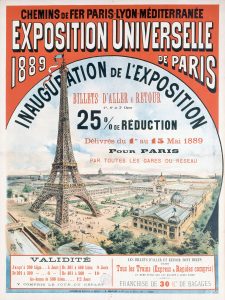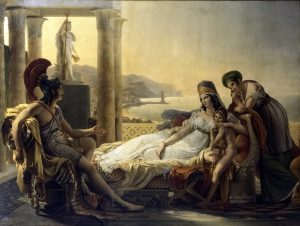Meryl Streep, Katharine Hepburn, and Bette Davis: Oscars Best Actress Nominations
Meryl Streep, Katharine Hepburn, and Bette Davis are legendary actresses who have left an indelible mark on the history of cinema. Each of them has received multiple nominations for the Academy Award for Best Actress, with their combined nominations totaling an impressive number.
As of my last update in January 2022, here is a breakdown of their nominations:
- Meryl Streep:
- Meryl Streep holds the record for the most Academy Award nominations for acting, with 17 nominations in total.
- She has won the Oscar for Best Actress three times:
- “Kramer vs. Kramer” (1979)
- “Sophie’s Choice” (1982)
- “The Iron Lady” (2011)
- Katharine Hepburn:
- Katharine Hepburn is one of the most celebrated actresses in Hollywood history. She received 12 nominations for the Academy Award for Best Actress, the most for any performer until Meryl Streep surpassed her.
- Hepburn won the Oscar for Best Actress four times:
- “Morning Glory” (1933)
- “Guess Who’s Coming to Dinner” (1967)
- “The Lion in Winter” (1968)
- “On Golden Pond” (1981)
- Bette Davis:
- Bette Davis received ten nominations for the Academy Award for Best Actress.
- Davis won the Oscar for Best Actress twice:
- “Dangerous” (1935)
- “Jezebel” (1938)
These three actresses are icons of the silver screen, and their contributions to cinema have been recognized with numerous accolades and awards, including their multiple nominations and wins at the Oscars.
Meryl Streep: A Legacy of Excellence
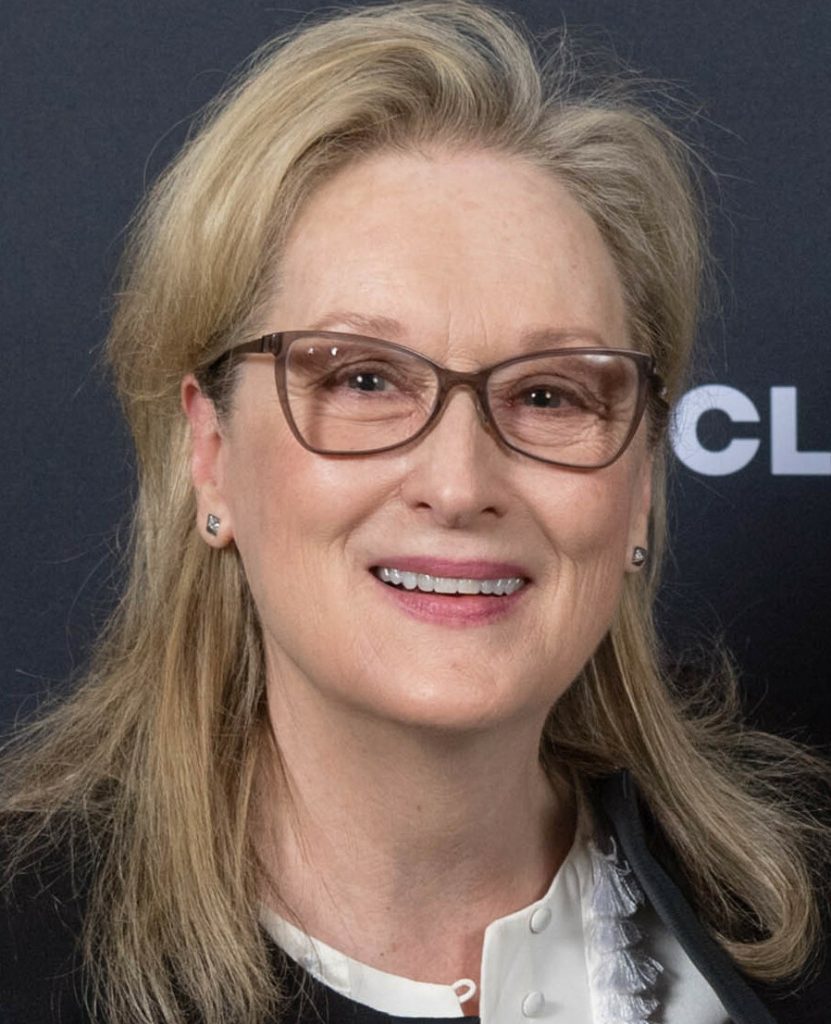
Streep in 2018 (Wiki Image).
Born June 22, 1949, Summit, New Jersey, U.S.
Women are better at acting than men. Why? Because we have to be. If successfully convincing somebody bigger than you of something he doesn’t know is a survival skill, this is how women have survived through the millennia. Pretending is not just play. Pretending is an imagined possibility. Pretending or acting is a very valuable life skill, and we all do it. All the time.
— Streep in acting (Wiki Quotes)
| Year | Movie Title | Role | Notes |
|---|---|---|---|
| 1977 | Julia | Anne Marie | Film Debut |
| 1978 | The Deer Hunter | Linda | First Academy Award Nomination (Supporting Actress) |
| 1979 | Kramer vs. Kramer | Joanna Kramer | Won Academy Award for Best Actress |
| 1981 | The French Lieutenant’s Woman | Sarah/Anna | Dual Role |
| 1982 | Sophie’s Choice | Sophie Zawistowski | Won Academy Award for Best Actress |
| 1983 | Silkwood | Karen Silkwood | Nominated for Academy Award (Best Actress) |
| 1985 | Out of Africa | Karen Blixen | Nominated for Academy Award (Best Actress) |
| 1987 | Ironweed | Helen Archer | Nominated for Academy Award (Best Actress) |
| 1988 | A Cry in the Dark | Lindy Chamberlain | Nominated for Academy Award (Best Actress) |
| 1992 | Death Becomes Her | Madeline Ashton | Comedy Role |
| 1995 | The Bridges of Madison County | Francesca Johnson | Nominated for Academy Award (Best Actress) |
| 1998 | One True Thing | Kate Gulden | |
| 1999 | Music of the Heart | Roberta Guaspari | Nominated for Academy Award (Best Actress) |
| 2002 | The Hours | Clarissa Vaughan | |
| 2006 | The Devil Wears Prada | Miranda Priestly | Nominated for Academy Award (Best Actress) |
| 2008 | Doubt | Sister Aloysius Beauvier | Nominated for Academy Award (Best Actress) |
| 2008 | Mamma Mia! | Donna Sheridan | Musical Role |
| 2009 | Julie & Julia | Julia Child | Nominated for Academy Award (Best Actress) |
| 2011 | The Iron Lady | Margaret Thatcher | Won Academy Award for Best Actress |
| 2013 | August: Osage County | Violet Weston | Nominated for Academy Award (Best Actress) |
| 2014 | Into the Woods | The Witch | Musical Role |
| 2016 | Florence Foster Jenkins | Florence Foster Jenkins | Nominated for Academy Award (Best Actress) |
| 2018 | The Post | Katharine Graham | Nominated for Academy Award (Best Actress) |
| 2019 | Little Women | Aunt March |
Meryl Streep, born Mary Louise Streep in 1949, is considered one of the greatest actresses ever. Her career spans over four decades and is marked by incredible versatility, captivating performances, and numerous accolades. Here’s a deeper look into her history:
Early Life and Education:
- Born in Summit, New Jersey, Streep aspired to be an opera singer.
- She transitioned to acting while studying at Vassar College, graduating with a drama and costume design degree in 1971.
- She further honed her skills at Yale School of Drama, earning a Master of Fine Arts in 1975.
Stage and Screen Debut:
- Streep began her professional career on stage in New York City in the mid-1970s.
- Her film debut came in 1977 with a supporting role in “Julia.”
- Her breakthrough performance followed in the war drama The Deer Hunter (1978), which earned her her first Academy Award nomination.
Rise to Stardom:
- The 1980s solidified Streep’s position as a leading actress.
- She delivered iconic performances in films like:
- “Kramer vs. Kramer” (1979) – winning her first Oscar for Best Supporting Actress
- “The French Lieutenant’s Woman” (1981)
- “Sophie’s Choice” (1982)
- “Out of Africa” (1985)
Versatility and Continued Success:
- Streep is known for her incredible range, portraying diverse characters with mastery.
- Her filmography includes comedies, dramas, historical pieces, and musicals.
- Some notable films from her later career include:
- “The Devil Wears Prada” (2006)
- “Doubt” (2008)
- “The Iron Lady” (2011) – winning her third Oscar for Best Actress
- “Florence Foster Jenkins” (2016)
- “Little Women” (2019)
Accolades and Legacy:
- Streep holds the record for most Academy Award nominations for Best Actress (17) with three wins.
- She has also received numerous Golden Globe Awards, BAFTA Awards, and other accolades.
- Beyond awards, Streep is celebrated for her dedication to her craft, ability to breathe life into characters, and powerful on-screen presence.
Meryl Streep continues to be a force in Hollywood, captivating audiences and inspiring aspiring actors. Her legacy is excellence, versatility, and a deep commitment to acting.
Meryl Streep: Early Life, Education, and Stepping onto the Stage and Screen
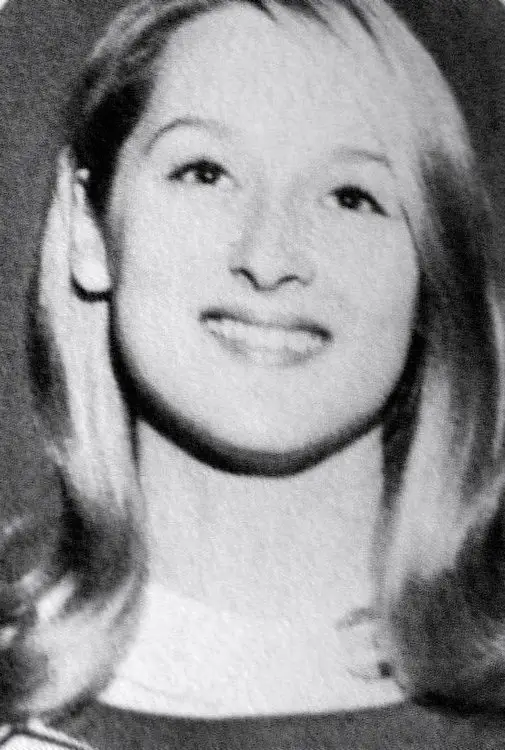
Streep was a senior in high school in 1966 (Wiki Image).
Early Life and Education:
- Born Mary Louise Streep in 1949 in New Jersey, Streep wasn’t initially drawn to serious theater.
- However, her interest grew in high school, and she participated in numerous school plays.
- This passion continued at Vassar College, where she received a drama and costume design degree in 1971.
- Her talent blossomed at Vassar, particularly after appearing in the play “Miss Julie.”
- To further hone her craft, she pursued a Master of Fine Arts degree at the prestigious Yale School of Drama, graduating in 1975.
Stage Debut:
- Wasting no time after Yale, Streep dove headfirst into the professional theater scene in New York City in 1975.
- Her debut came with a role in Trelawny of the Wells at The Public Theater.
- This wasn’t just any debut; her performance garnered critical acclaim and a Tony Award nomination the following year, solidifying her talent.
Screen Debut:
- While Streep’s stage career took off quickly, her film debut was more nuanced.
- Technically, her first credited film role was in Julia (1977).
- However, most of her scenes were cut, leaving her with minimal screen time and reportedly causing her to doubt her film potential.
This early experience on film contrasts with the acclaim she would receive just a year later with her powerful performance in “The Deer Hunter” (1978).
The Deer Hunter (1978)
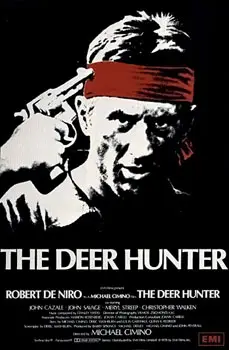
(Wiki Image).
- “You’re so full of shit, you’re gonna float away.” – This quote by Stan, one of the friends about to be shipped off to Vietnam, highlights the dark humor and tension present before their deployment.
- “A deer has to be taken with one shot. I try to tell people that, but they don’t listen.” – Michael, the leader of the hunting group, emphasizes the importance of precision and focus, foreshadowing the potential dangers of war.
- “When a man says no to champagne, he says no to life.” – Julien Grinda, the owner of the Russian roulette game, uses this line to entice the captured soldiers to play. It reflects the cynical manipulation they face.
- “C’mon! You didn’t get a DEE-E-EAH?” – This desperate plea from Nick during the brutal Russian roulette scene underscores the psychological torment inflicted on the soldiers.
- “Stanley, see this? This is this. This ain’t something else. This is this. From now on, you’re on your own.” – Michael speaks harshly to a disillusioned Stanley, highlighting the loss of innocence and the breakdown of their previous camaraderie due to the war’s trauma.
The Deer Hunter (1978) is a powerful American epic war drama film co-written and directed by Michael Cimino. Here’s a breakdown of the film:
Plot:
The story centers around a group of working-class friends from a Pennsylvania steel town whose lives are forever changed by the Vietnam War. The film follows them before, during, and after their deployment, highlighting the psychological trauma and devastating impact of war.
Key Characters:
- Michael (Robert De Niro): A central character and steelworker who grapples with the horrors of war upon returning home.
- Nick (Christopher Walken): Another steelworker and friend of Michael, deeply affected by his wartime experiences.
- Steven (John Savage): A third friend who gets severely injured in the war.
- Linda (Meryl Streep): Michael’s girlfriend who waits for him and embodies the anxieties of those left behind.
Themes:
- The psychological impact of war on soldiers and their families.
- Loss of innocence and the struggle to reintegrate into society after war.
- The importance of friendship and community.
- The brutality and senselessness of war.
Critical Reception:
The Deer Hunter received critical acclaim for its powerful performances, particularly by De Niro, Walken, and Streep. It also sparked discussions for its realistic portrayal of the Vietnam War’s brutality. The film won five Academy Awards, including Best Picture and Best Director.
Legacy:
The Deer Hunter remains a significant film in American cinema, remembered for its unflinching portrayal of war and its lasting effects. It continues to be a source of discussion and analysis for its exploration of trauma, resilience, and the human cost of war.
Rise to Stardom
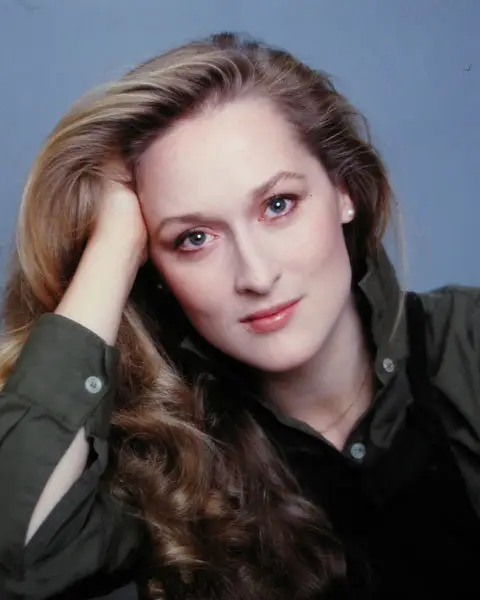
Streep in 1977 (Wiki Image).
Meryl Streep’s rise to stardom wasn’t meteoric but rather a steady climb fueled by powerful performances on stage and screen. Here’s a closer look at her path:
- Sharpening the Craft (Early & Mid-1970s): Streep honed her acting skills in theater productions after graduating from Yale with a Master’s in Fine Arts. Her Broadway debut in 1975 garnered critical attention and a Tony Award nomination.
- Breakthrough Roles (Late 1970s): While her film debut in 1977 with “Julia” was well-received, it was her supporting role in “The Deer Hunter” (1978) that put her on the map. Her emotional depth in the character earned her an Academy Award nomination. That same year, she won her first Emmy for the miniseries “Holocaust.”
- From Acclaim to Accolades (Early 1980s): The 1980s solidified Streep’s place as a force to be reckoned with. She won her first Oscar for Best Supporting Actress in “Kramer vs. Kramer” (1979), followed by a Best Actress win for her harrowing portrayal of a Holocaust survivor in “Sophie’s Choice” (1982). These back-to-back wins cemented her reputation for exceptional talent and range.
- Versatility on Display (Mid-1980s to Present): Streep never settled for typecasting. Throughout her career, she tackled diverse roles in dramas like “Silkwood” and “Out of Africa,” showcased her comedic chops in “Death Becomes Her” and “The Devil Wears Prada,” and even sang her way through musicals like “Mamma Mia!” This versatility kept audiences and critics engaged, showcasing her exceptional range as an actress.
Key Factors in Her Rise:
- Early Critical Recognition: Awards and nominations from prestigious institutions like the Oscars and Tonys brought Streep national and international recognition.
- Powerful Performances: Critics and audiences alike were captivated by the emotional depth and believability she brought to each character.
- Smart Role Choices: She consistently selected roles that challenged her and allowed her to showcase her versatility.
- Dedication to the Craft: Streep’s meticulous preparation and commitment to understanding her characters is well-documented, adding another layer of respect to her work.
Meryl Streep’s rise to stardom wasn’t about overnight fame but rather a testament to her dedication, exceptional talent, and consistent delivery of powerful performances that left audiences and critics in awe.
“Kramer vs. Kramer” (1979) – winning her first Oscar for Best Supporting Actress
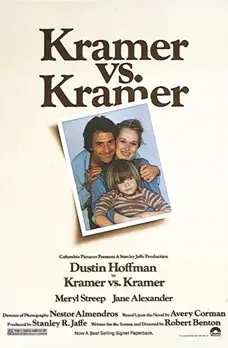
(Wiki Image).
- “We used to have ice cream every night after dinner. Remember? Vanilla with chocolate syrup.” – Billy (Justin Henry) to Ted (Dustin Hoffman), showing the child’s longing for normalcy and the routine disrupted by his mother’s absence.
- “Don’t tell me what I can or cannot do! Don’t talk to me that way!” – Joanna (Meryl Streep) to Ted, reflecting the frustration and resentment that led to her leaving and a hint of possessiveness towards her son.
- “You’re late.” – Billy to Ted, a simple yet powerful statement highlighting the initial tension and adjustment in their new dynamic as Ted struggles to fulfill both parental roles.
- “Daddy? Are you going away? … What if you get run over by a truck and get killed? Then what happens?” – Billy expresses his fear of abandonment after his mother leaves, a fear many children face during divorce.
- “See you in the morning light.” – Ted to Billy, a tender moment showcasing the growing bond between father and son as they navigate the challenges of their new life together.
Kramer vs. Kramer (1979) Trailer #1 | Movieclips Classic Trailers
(YouTube video)
“Kramer vs. Kramer” (1979) is a legal drama film exploring the emotional toll of divorce, particularly on a young child. Here’s a deeper look:
Plot:
Ted Kramer (Dustin Hoffman), a workaholic advertising executive, is blindsided when his wife Joanna (Meryl Streep) leaves him and their young son Billy (Justin Henry). Forced to become a single parent, Ted struggles to balance his demanding career with caring for Billy. They develop a stronger bond while Joanna is gone. However, Joanna returns and seeks custody of Billy, leading to a bitter court battle that forces everyone to confront their priorities and the true meaning of family.
Themes:
- The impact of divorce on children and parents.
- The challenges and rewards of single parenthood.
- The dynamic between fathers and sons and the evolution of their roles.
- Gender roles and societal expectations in child-rearing.
- The emotional complexities of love, loss, and forgiveness.
Critical Reception:
“Kramer vs. Kramer” was a critical and commercial success. It received praise for its realistic portrayal of divorce, strong performances by Hoffman and Streep (who both won Oscars), and its exploration of complex emotions. The film sparked discussions about changing gender roles and the importance of fathers in children’s lives.
Legacy:
“Kramer vs. Kramer” remains a powerful and relevant film. It continues to resonate with audiences due to its timeless themes and ability to capture the complexities of family dynamics.
“The French Lieutenant’s Woman” (1981)
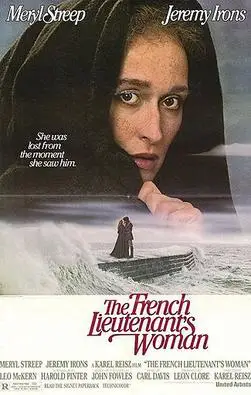
(Wiki Image).
- “The past is a foreign country: they do things differently there.” The narrator echos this line from “Sophie’s Choice,” which reflects the different societal constraints placed on women in Victorian England compared to the present day.
- “I cannot! I cannot! … You are a remarkable person, Miss Woodruff.” – Sarah (Meryl Streep) expresses her frustration, and Charles (Jeremy Irons) acknowledges her complexity in this exchange, highlighting the tension and attraction between them despite societal disapproval.
- “In 1857, it’s estimated there were 80,000 prostitutes in the county of London.” – Anna (Meryl Streep, playing the actress portraying Sarah) reads a historical fact, blurring the lines between reality and fiction within the film’s narrative.
- “I have long imagined a day such as this. I have longed for it. I was lost from the moment I saw you.” Sarah confesses her deep feelings for Charles, showcasing their romance’s passionate and forbidden nature.
- “We may never know the truth. Perhaps the truth is unimportant. Perhaps the poetry is enough.” The narrator contemplates Sarah’s past ambiguity, suggesting that the story’s emotional impact transcends historical accuracy.
“The French Lieutenant’s Woman” (1981) is a romantic drama film with a unique twist. It’s an adaptation of John Fowles’s postmodern novel of the same name and explores themes of love, societal constraints, and the blurring lines between reality and fiction.
Plot:
The film unfolds in two interwoven stories. The primary narrative follows Charles Smithson (Jeremy Irons), a Victorian paleontologist visiting the seaside town of Lyme Regis. He becomes captivated by Sarah Woodruff (Meryl Streep), a beautiful woman ostracized by the community for her scandalous past. Their forbidden romance blossoms despite societal pressures and Sarah’s ambiguous history.
The secondary narrative takes place in the present day, depicting the filming of a movie based on the story of Charles and Sarah. The actors Anna (Meryl Streep) and Mike (Jeremy Irons) find their lives mirroring the passionate characters they portray, blurring the lines between reality and the fictional world.
Themes:
- The power of forbidden love and defying social norms.
- The subjective nature of truth and perception.
- The exploration of female sexuality and societal double standards.
- The blurring of lines between fiction and reality, particularly in the context of film and storytelling.
- The timeless nature of human emotions and desires.
Critical Reception:
“The French Lieutenant’s Woman” received positive reviews. It was praised for its innovative storytelling, strong performances by Streep and Irons, and intriguing blend of historical drama and metafiction. However, some critics found the pacing slow and the ending ambiguous.
Legacy:
The film remains a significant work of cinematic adaptation, known for its experimental narrative and exploration of audience engagement. Streep and Irons’ performances are lauded for their depth and emotional complexity. “The French Lieutenant’s Woman” holds a unique place in film history, prompting discussions about storytelling methods and the power of film to transcend time and reality.
“Sophie’s Choice” (1982)
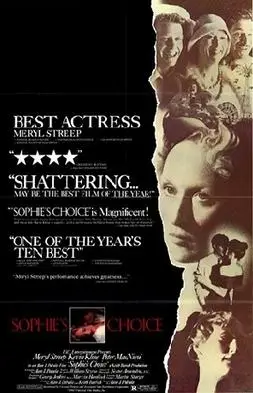
(Wiki Image).
- “The past is a foreign country. They do things differently there.” – This haunting line by Nathan (Kevin Kline) reflects Sophie’s (Meryl Streep) difficulty reconciling with her wartime experiences and the trauma she carries.
- “They took everything. They took my life; they took my future; they took my children. They took my name. What’s left?” – Sophie’s raw statement to Nathan captures the devastating impact of the concentration camps and her struggle to rebuild an identity.
- “There never was a choice. There never was a choice.” Sophie desperately repeats this line after revealing the agonizing decision she was forced to make during the war, highlighting her lack of agency in an impossible situation.
- “I just want to be ordinary. Happy. Like people in magazines.” Sophie yearns for a normal life far removed from the horrors she has witnessed.
- “We can’t change the past, Sophie. But we can choose how we let it affect us.” – Nathan attempts to offer comfort and a path forward despite the weight of Sophie’s past.
Sophie’s Choice Official Trailer #1 – Meryl Streep, Kevin Kline …
(YouTube video)
“Sophie’s Choice” (1982) is a psychological drama film based on the novel of the same name by William Styron. It’s a harrowing exploration of trauma, survival, and the impossible choices people make during war. Here’s a closer look:
Plot:
The story centers on Sophie Zawistowska (Meryl Streep), a Polish Catholic immigrant living in Brooklyn after surviving the horrors of a Nazi concentration camp. She grapples with PTSD and a mysterious past while entangled with a passionate but volatile American writer named Nathan (Kevin Kline). As their relationship unfolds, disturbing memories of the war resurface, revealing a horrifying choice Sophie had to make to save one of her loved ones.
Themes:
- The lasting psychological trauma of war and concentration camps.
- The burden of impossible choices and the weight of guilt.
- The complexities of love and relationships in the face of trauma.
- The struggle to rebuild a life after unimaginable suffering.
- The importance of memory and confronting the past.
Critical Reception:
“Sophie’s Choice” was a critical and commercial success. Streep’s performance as Sophie garnered widespread acclaim, winning her the Academy Award for Best Actress. However, the film also sparked controversy due to its graphic depictions of violence and the emotional intensity of Sophie’s ordeal.
Legacy:
Despite the controversy, “Sophie’s Choice” remains a powerful and thought-provoking film. It serves as a stark reminder of the human cost of war and the enduring impact of trauma. Streep’s performance is considered a masterclass in emotional depth, and the film continues to be studied for its exploration of complex themes and its ability to evoke empathy for its characters.
“Out of Africa” (1985)
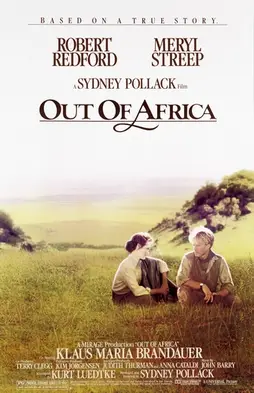
(Wiki Image).
- “I had a farm in Africa, at the foot of the Ngong Hills. The equator runs right through my dining room table.” – Karen Blixen’s (Meryl Streep) opening narration sets the scene and introduces the film’s sense of adventure and vastness.
- “I respect what you do, Denys, but I cannot live the life of a nomad.” – This line from Karen to Denys Finch Hatton (Robert Redford) highlights their clashing desires. She craves stability and a sense of belonging, while he embodies a free-spirited, adventurous lifestyle.
- “We’ll always be friends, won’t we?” – Denys asks Karen, expressing their deep connection despite the impracticality of a romantic future together. This bittersweet line encapsulates the complicated nature of their love.
- “I’ve learned to endure what I cannot change.” – Karen reflects on her resilience in the face of hardship, loss, and the changing realities of her African life.
- “Perhaps in Africa, unlike anywhere else, you can forget all the things that went before.” – This quote captures Karen’s allure of Africa, a place where she could escape the limitations of her past and forge a new identity.
“Out of Africa” (1985) is a sweeping romantic drama film based on the autobiographical book by Isak Dinesen (pen name of Karen Blixen). It chronicles her experiences running a coffee plantation in colonial Kenya during the early 20th century.
Plot:
A Danish baroness, Karen Blixen (Meryl Streep), arrives in Kenya with her aristocratic husband, Bror (Klaus Maria Brandauer), to start a dairy farm. However, Bror’s mismanagement leads them to switch to a coffee plantation. As Karen builds a new life, she develops a complex and passionate relationship with Denys Finch Hatton (Robert Redford), a free-spirited big-game hunter.
Their connection is both exhilarating and fraught with tension—Denys’ adventurous lifestyle clashes with Karen’s desire for stability and a family. Meanwhile, the changing political landscape and economic struggles threaten her African efforts.
Themes:
- The allure and challenges of a life less ordinary in a foreign land.
- The complexities of love and the clash between passion and practicality.
- The struggle to find belonging and purpose amidst cultural differences.
- Loss, resilience, and the bittersweet beauty of impermanence.
- The fading colonial era and the changing face of Africa.
Critical Reception:
“Out of Africa” was a critical and commercial success. It earned widespread praise for its breathtaking cinematography that captures the vastness and beauty of the African landscape. Streep and Redford’s performances were lauded for their emotional depth and chemistry. The film won seven Academy Awards, including Best Picture and Best Director.
Legacy:
“Out of Africa” remains a visually stunning and emotionally resonant film. It offers a nuanced portrayal of Karen Blixen’s experiences, showcasing the joys and hardships of a life outside societal norms. The film continues to captivate audiences with its exploration of love, loss, and the enduring power of nature.
Versatility and Continued Success
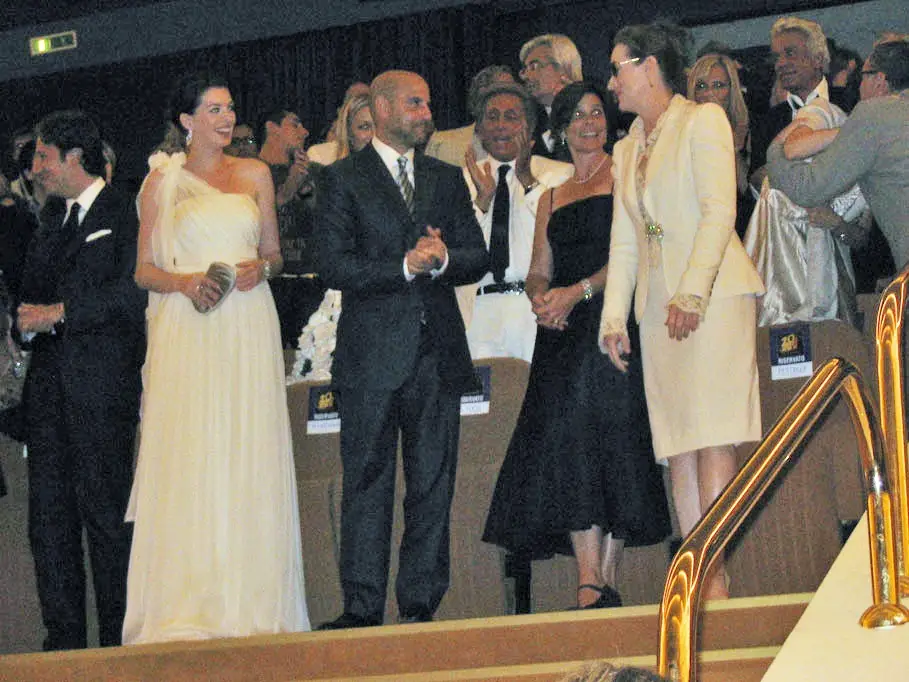
Streep (right) at the Venice premiere of The Devil Wears Prada in 2006 (Wiki Image).
Meryl Streep’s reputation rests on two key pillars: her unmatched versatility as an actress and her sustained success over several decades. Let’s break these down:
Versatility:
- Chameleon-like Transformations: Streep has the incredible ability to inhabit completely different characters. From the icy Miranda Priestly in “The Devil Wears Prada” to the strong-willed Margaret Thatcher in “The Iron Lady,” she disappears into each role, adopting accents, mannerisms, and physicalities that make them believable and unforgettable.
- Genre-Bending Range: She isn’t confined to a single genre. She’s excelled in dramas like “Kramer vs. Kramer” and “Sophie’s Choice,” brought heart to comedies like “Mamma Mia!” and “It’s Complicated,” and even tackled historical figures and musicals.
Continued Success:
- Longevity and Awards Recognition: Streep’s career spans over five decades and shows no signs of slowing down. She holds the record for most Academy Award nominations for Best Actress (21) and has won three Oscars.
- Critical Acclaim: Her performances are consistently lauded by critics. She’s garnered critical acclaim for leading and supporting roles, showcasing her adaptability.
- Commercial Viability: Despite critical acclaim, Streep isn’t just about awards. Her films are also box office successes, proving her popular appeal transcends artistic merit.
The Secret Sauce:
So, what’s the secret to Streep’s enduring success? It’s likely a combination of factors:
- Dedication and Craft: She’s known for her meticulous preparation and commitment to her characters.
- Intelligent Role Selection: She chooses diverse roles that challenge her and showcase her talent.
- Adaptability and Growth: She’s constantly evolving as an actress, taking on new challenges and staying relevant.
Meryl Streep is a true icon who has redefined what it means to be a successful actress. Her versatility and unwavering dedication to her craft continue to inspire audiences and fellow actors alike.
“The Devil Wears Prada” (2006)
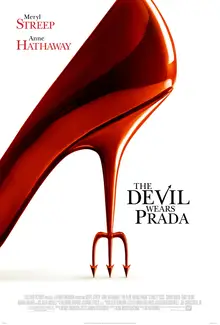
(Wiki Image).
- “Florals for spring? Groundbreaking.” – Miranda Priestly’s (Meryl Streep) sarcastic dismissal of Andy’s (Anne Hathaway) fashion suggestion is a now-iconic line, highlighting Miranda’s sharp wit and the demanding nature of the fashion industry.
- “That’s all? – Miranda to Andy after a long list of errands. This seemingly simple question emphasizes the relentless expectations placed on Andy and the pressure to anticipate Miranda’s every need.
- “Excuse me, can we adjust the attitude? Don’t make me feed you to one of the models.” – Miranda’s sharp criticism of Andy’s initial lack of fashion knowledge showcases her intimidating presence and the power dynamics at play.
- “I’m not your friend. And you’re not mine.” – Miranda’s blunt statement clarifies the professional boundaries between her and Andy, contrasting with the camaraderie Andy seeks in the workplace.
- “Everybody wants to be us.” – Nigel (Stanley Tucci) to Andy, a statement reflecting the glamorous exterior of the fashion world while hinting at the hidden sacrifices and pressures it faces.
“The Devil Wears Prada” (2006) is a comedy-drama film based on Lauren Weisberger’s novel. It’s a satirical look at the cutthroat world of high fashion magazines and the ambitious young woman who navigates it.
Plot:
Andy Sachs (Anne Hathaway) is a recent college graduate with dreams of becoming a journalist. Landing a seemingly dream job as an assistant to Miranda Priestly (Meryl Streep), the powerful and demanding editor-in-chief of Runway magazine, Andy quickly discovers the reality is far from glamorous. Miranda is notoriously difficult and expects nothing short of perfection from her staff.
Andy needs help to keep up with Miranda’s relentless demands, the demanding tasks of the fashion world, and the constant pressure to look perfect. Torn between her initial aspirations and the potential opportunities her job offers, Andy must decide how far she’s willing to go to succeed and if the sacrifices are worth the price.
Themes:
- The allure and challenges of working in a fast-paced, competitive industry.
- The importance of finding your voice and staying true to yourself.
- There is pressure to conform to societal expectations, particularly for women.
- The power dynamics between superiors and subordinates.
- The value of work ethic, self-reliance, and perseverance.
- The superficiality and dark side of the fashion world.
Critical Reception:
“The Devil Wears Prada” was a box office success and received generally positive reviews. Streep’s portrayal of the ruthless Miranda Priestly was particularly lauded, earning her an Academy Award nomination. The film resonated with audiences for its humor, relatable protagonist, and behind-the-scenes glimpse into the fashion industry.
Legacy:
“The Devil Wears Prada” remains a popular and quotable film. It offers a comedic yet thought-provoking look at the sacrifices women often face in the workplace and the pursuit of professional success. Streep’s performance continues to be a highlight, and the film serves as a cautionary tale about ambition and the importance of maintaining one’s integrity.
“Doubt” (2008)
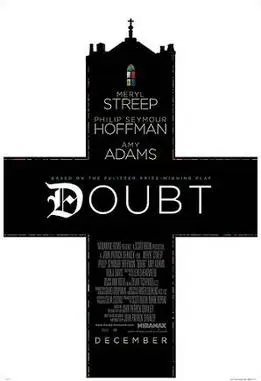
(Wiki Image).
- “Doubt is a terrible thing. It is like a worm that bores through the soul.” – Sister Aloysius (Meryl Streep) expresses her unwavering faith and her belief that any suspicion, even unproven, demands action.
- “Isn’t a good name worth protecting? Isn’t a child’s innocence worth everything?” – This line from Sister Aloysius emphasizes her determination to safeguard the children but hints at the potential for self-righteousness in her pursuit.
- “Where there’s smoke, there’s fire.” Sister Aloysius’s proverb reflects her approach to suspicion. However, the film leaves the audience questioning whether there’s actually fire or just smoke.
- “Has it ever occurred to you that you may be wrong?” – Father Flynn (Philip Seymour Hoffman) challenges Sister Aloysius’ certainty, raising doubts about her motivations and the potential for misinterpretations.
- “We can only see what we are prepared to see.” – This final quote, spoken by the narrator, leaves the truth ambiguous and prompts reflection on the subjective nature of perception and the limitations of human judgment.
“Doubt” (2008) is a suspenseful drama film based on John Patrick Shanley’s Pulitzer Prize and Tony Award-winning play. It explores themes of faith, suspicion, and the complexities of human nature within a Catholic school setting.
Plot:
The story centers on Sister Aloysius Beauvier (Meryl Streep), a stern and traditional principal at St. Nicholas Catholic School in 1964. When Sister James (Amy Adams), a young and idealistic teacher, expresses concerns about the close relationship between Father Flynn (Philip Seymour Hoffman), a charismatic priest, and a young male student, Donald Miller (Joseph Fiennes), Sister Aloysius becomes suspicious.
Driven by her unwavering faith and belief in protecting the children, Sister Aloysius embarks on a personal crusade to uncover the truth. She investigates Father Flynn’s behavior and interactions with Donald, planting seeds of doubt in the minds of those around her. However, without concrete evidence, the film leaves the audience questioning the validity of her accusations and the motives behind them.
Themes:
- The power of suspicion and the struggle to discern truth from rumor.
- The clash between faith and doubt within a religious institution.
- The weight of authority and the potential for misuse of power.
- The complexities of human relationships and the ambiguity of actions.
- The vulnerability of children and the responsibility to protect them.
Critical Reception:
“Doubt” received critical acclaim for its superb performances, particularly Streep and Hoffman, who both earned Academy Award nominations. The film was praised for its intelligent script, suspenseful atmosphere, and exploration of moral ambiguity.
Legacy:
“Doubt” remains a powerful and thought-provoking film. It delves into sensitive topics with nuance and avoids easy answers. The film continues to spark discussions about faith, justice, and the importance of critical thinking, even within the context of established institutions.
“The Iron Lady” (2011) – winning her third Oscar for Best Actress.
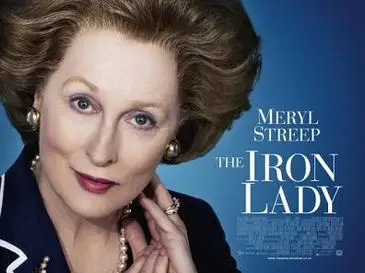
(Wiki Image).
- “Power is like a magnificent antique car. It can take you to some wonderful places, but you have to know how to handle it.” – Margaret Thatcher (Meryl Streep) reflects on the responsibility and challenges that come with leadership.
- “I fight on principle, and those who don’t understand that, well, they don’t understand history.” – This line showcases Thatcher’s unwavering convictions and willingness to stand firm even when facing opposition.
- “You have to be a bloody tough bird to make it in this business.” Denis Thatcher (Jim Broadbent) candidly observes Margaret’s challenges as the first female Prime Minister.
- “Sometimes you just have to go for it. That’s what we British do. We muddle through.” – This quote reveals a more pragmatic side to Thatcher, acknowledging the need for flexibility and resilience in complex situations.
- “My conscience is clear. I did what I thought was right.” – This final line, spoken by an elderly Margaret, emphasizes her unwavering belief in her decisions and legacy, even as she grapples with the weight of the past.
The Iron Lady Official Movie Trailer [HD]
(YouTube video)
“The Iron Lady” (2011) is a biographical drama film centered on Margaret Thatcher, the first and only female Prime Minister of the United Kingdom. Directed by Phyllida Lloyd and written by Abi Morgan, the film explores Thatcher’s life and legacy, weaving her past and present.
Plot:
The film primarily focuses on Thatcher’s later years, as she struggles with dementia and grapples with the weight of her past decisions. Told through a fragmented narrative, the film intercuts scenes from her past – her rise from a grocer’s daughter to a powerful politician – with her present struggles to let go of the past and reconcile with her legacy.
Key Characters:
- Margaret Thatcher (Meryl Streep): The central character, portrayed at different stages of her life by Streep and Alexandra Roach. The film explores her determination, strong will, and the personal sacrifices she made for her political career.
- Denis Thatcher (Jim Broadbent): Margaret’s supportive husband who serves as her confidante and emotional anchor.
- Young Margaret Thatcher (Alexandra Roach): Showcasing Thatcher’s formative years and the experiences that shaped her political beliefs.
Themes:
- The price of power and the sacrifices it demands.
- The legacy of a controversial figure and the challenges of historical interpretation.
- The complexities of aging and the struggle to maintain identity with memory loss.
- The role of women in leadership and the challenges they face.
- The impact of political decisions on the lives of individuals and the nation.
Critical Reception:
“The Iron Lady” received mixed reviews. While Streep’s performance as Thatcher was widely praised for its nuance and transformation, the film was criticized for its one-sided portrayal and historical inaccuracies. Some audience members found it sympathetic, while others saw it as overly critical.
Legacy:
Despite the mixed reception, “The Iron Lady” remains a significant film for sparking discussions about Margaret Thatcher’s legacy and the challenges of biographical filmmaking. Streep’s performance continues to be a highlight, showcasing her ability to embody complex characters on screen.
“Florence Foster Jenkins” (2016)
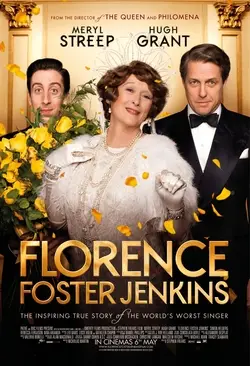
(Wiki Image).
- “Anyone can appreciate beauty. But to create it? That’s a gift.” – Florence Foster Jenkins (Meryl Streep) expresses her deep passion for music and her belief that anyone can aspire to be an artist.
- “The only thing worse than singing badly is not singing at all.” – This quote from Florence highlights her unwavering determination to pursue her dream, regardless of her lack of talent.
- “People may say I couldn’t sing, but no one can ever say I didn’t sing.” – Florence acknowledges her limitations but takes pride in her boldness and confidence.
- “Darling, it isn’t about the notes you hit. It’s about the music you make.” – St. Clair Bayfield (Hugh Grant) offers a comforting and supportive perspective, focusing on Florence’s passion rather than her technical skill.
- “A little laughter is a good thing. It shows you have a sense of humor, even if it’s about yourself.” Florence demonstrates grace and self-awareness despite her public humiliation at Carnegie Hall.
“Florence Foster Jenkins” (2016) is a biographical comedy-drama film based on the true story of Florence Foster Jenkins, a New York socialite with a passion for opera and a hilariously bad singing voice. Directed by Stephen Frears and written by Nicholas Martin and Julia Kogan, the film explores themes of love, ambition, and the power of self-deception.
Plot:
The film centers on Florence Foster Jenkins (Meryl Streep), an aging socialite who dreams of becoming a great opera singer. Despite possessing a voice widely considered awful, Florence remains oblivious to her lack of talent. Her devoted husband and manager, St. Clair Bayfield (Hugh Grant), orchestrates elaborate schemes to protect her from the truth. He hires supportive musicians, arranges private recitals with sycophantic audiences, and suppresses negative criticism.
As Florence’s delusions of grandeur grow, she sets her sights on performing at the prestigious Carnegie Hall. St. Clair faces his biggest challenge yet, scrambling to maintain Florence’s fantasy while preparing for the public humiliation that seems inevitable.
Themes:
- The importance of love and support in pursuing one’s dreams.
- The power of self-confidence, even if misplaced.
- The line between ambition and delusion.
- The complexities of aging and the desire to remain youthful.
- The joy of music and performance, regardless of skill level.
Critical Reception:
“Florence Foster Jenkins” received positive reviews, praised for its heartwarming story, witty script, and charming performances. Streep’s portrayal of the delusional yet endearing Florence was particularly lauded, earning her an Academy Award nomination. The film resonated with audiences for its humor, touching story about love and devotion, and celebration of the human spirit.
Legacy:
“Florence Foster Jenkins” is a lighthearted yet poignant tale that reminds us that passion and enthusiasm are more important than perfection. The film continues to entertain audiences with its quirky story and Streep’s unforgettable performance, offering a glimpse into the remarkable life of an eccentric socialite.
Accolades and Legacy
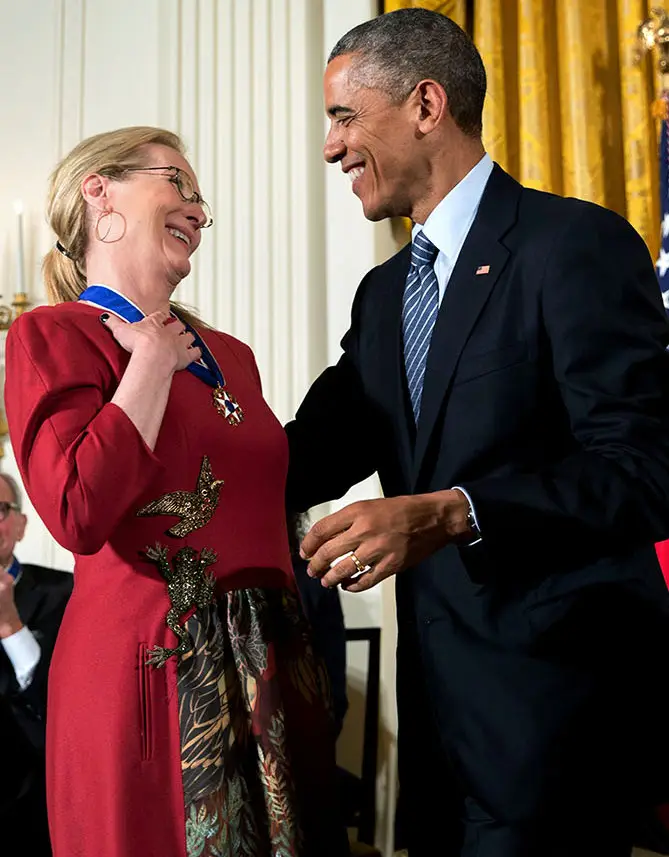
Streep received the Presidential Medal of Freedom from Barack Obama in 2014 (Wiki Image).
Meryl Streep’s accolades and legacy are truly remarkable. Here’s a breakdown of her achievements and the lasting impact she has on cinema:
Accolades:
- Record-Breaking Awards: Streep holds the record for the most Academy Award nominations for Best Actress (21) with three wins for “Kramer vs. Kramer” (1979), “Sophie’s Choice” (1982), and “The Iron Lady” (2011).
- Golden Globe Domination: She also has a record-breaking 33 Golden Globe nominations for Best Actress in a Leading Role, winning eight times.
- A Toast to Her Versatility: Her awards extend beyond Best Actress, recognizing her talent in various categories.
Legacy:
- The “Best Actress of Her Generation”: Streep is widely considered the greatest actress of her generation and perhaps of all time.
- A Master of Accents and Characters: Her chameleonic ability to transform into vastly different characters, accents, and physicalities is unmatched.
- Championing Complex Women: She consistently pushes boundaries by portraying complex, flawed, and unforgettable female characters, breaking stereotypes and challenging societal expectations.
- An Inspiration to Aspiring Actors: Her dedication, professionalism, and commitment to her craft serve as a beacon for aspiring actors worldwide.
- A Cultural Icon: Streep’s influence transcends acting. She is a respected voice on social issues and a cultural icon recognized for her intelligence, talent, and unwavering spirit.
Beyond the Awards:
- Longevity and Consistent Excellence: Streep’s career spans over four decades, with a continuous stream of critically acclaimed performances across various genres.
- Box Office Success: While not solely focused on commercial success, Streep has starred in numerous box office hits, proving her ability to deliver critically acclaimed and commercially viable films.
- A Body of Work That Inspires: Her filmography is a treasure trove of diverse characters and powerful performances that continue to be studied and admired by audiences and aspiring actors alike.
Meryl Streep’s legacy goes beyond the impressive number of awards she has received. She is a transformative actress who has redefined what it means to be a leading lady. She continues to inspire generations with her dedication, talent, and unwavering commitment to her craft. She is a true legend of cinema.
Katharine Hepburn: A Spirited Icon of Hollywood
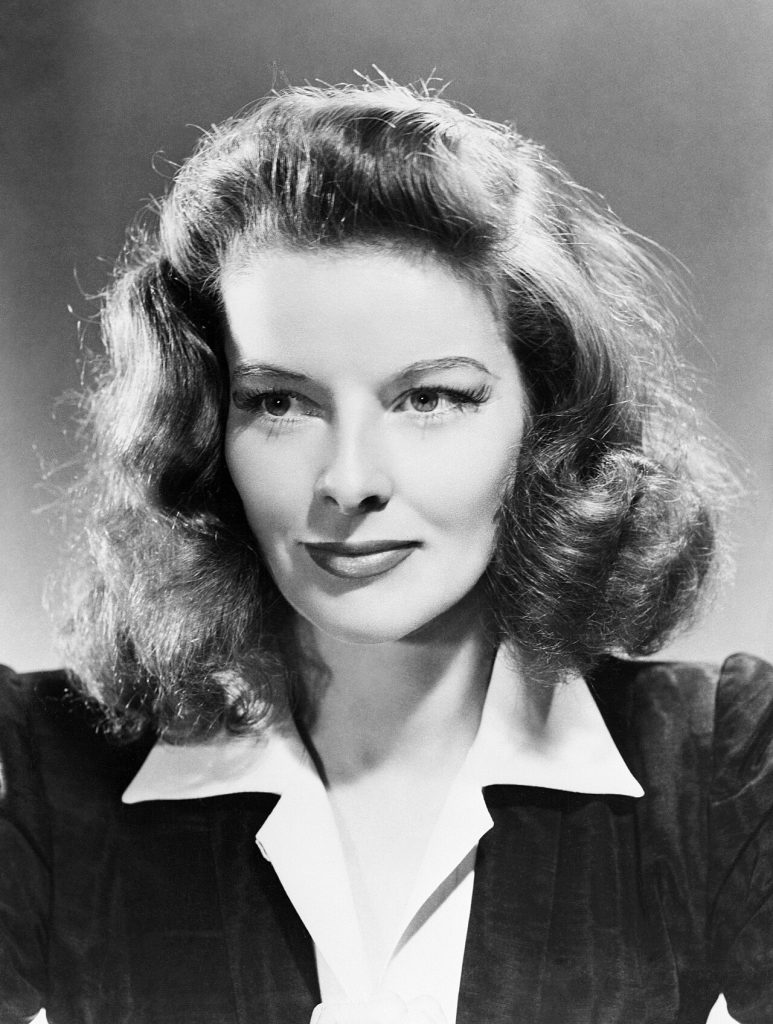
MGM studio publicity portrait, c. 1941 (Wiki Image).
Born May 12, 1907, Hartford, Connecticut, U.S.
Died June 29, 2003 (aged 96) Fenwick, Connecticut, U.S.
“I strike people as peculiar in some way, although I don’t quite understand why. Of course, I have an angular face, an angular body, and, I suppose, an angular personality, which jabs into people.”
“I’m a personality as well as an actress. Show me an actress who isn’t a personality, and you’ll show me a woman who isn’t a star.”
— Hepburn commenting on her personality. (Wiki Quotes).
| Year | Movie Title | Role | Notes |
|---|---|---|---|
| 1932 | A Bill of Divorcement | Sydney Fairfield | Film Debut |
| 1933 | Morning Glory | Eva Lovelace | Won Academy Award for Best Actress |
| 1933 | Little Women | Jo March | |
| 1934 | Spitfire | Trigger Hicks | |
| 1935 | Alice Adams | Alice Adams | Nominated for Academy Award (Best Actress) |
| 1936 | Mary of Scotland | Mary Stuart | |
| 1937 | Stage Door | Terry Randall | |
| 1938 | Bringing Up Baby | Susan Vance | Screwball Comedy Classic |
| 1940 | The Philadelphia Story | Tracy Lord | Nominated for Academy Award (Best Actress) |
| 1942 | Woman of the Year | Tess Harding | First film with Spencer Tracy |
| 1949 | Adam’s Rib | Amanda Bonner | With Spencer Tracy |
| 1951 | The African Queen | Rose Sayer | Nominated for Academy Award (Best Actress) |
| 1952 | Pat and Mike | Pat Pemberton | With Spencer Tracy |
| 1955 | Summertime | Jane Hudson | Nominated for Academy Award (Best Actress) |
| 1956 | The Rainmaker | Lizzie Curry | Nominated for Academy Award (Best Actress) |
| 1957 | Desk Set | Bunny Watson | With Spencer Tracy |
| 1962 | Long Day’s Journey Into Night | Mary Tyrone | Nominated for Academy Award (Best Actress) |
| 1967 | Guess Who’s Coming to Dinner | Christina Drayton | With Spencer Tracy, his final film |
| 1968 | The Lion in Winter | Eleanor of Aquitaine | Won Academy Award for Best Actress |
| 1981 | On Golden Pond | Ethel Thayer | Won Academy Award for Best Actress |
Katharine Hepburn (1907-2003) was an American actress who redefined what it meant to be a leading lady in Hollywood. Her career spanned an impressive six decades, marked by her fierce independence, strong screen persona, and unmatched talent. Here’s a glimpse into her remarkable history:
Early Life and Stage Beginnings:
- Born in Hartford, Connecticut, Hepburn possessed a strong spirit and love for acting from a young age.
- After graduating from Bryn Mawr College in 1928, she pursued acting in New York City.
- Her early career focused on-stage performances, where she established a reputation for her unconventional beauty and captivating presence.
Hollywood Debut and Early Struggles:
- In 1932, Hepburn made her film debut in “A Bill of Divorcement” opposite John Barrymore.
- Despite initial success, a string of box office flops led to professional difficulty.
- Unwilling to conform to Hollywood’s stereotypical leading lady image, she bought out her contract to regain creative control.
Rebirth as a Star:
- Hepburn’s gamble paid off with the screwball comedy “Bringing Up Baby” (1938), which he starred in alongside Cary Grant.
- This success revived her career and showcased her comedic talent.
- Throughout the 1940s and 1950s, she delivered powerful performances in films like:
- “The Philadelphia Story” (1940)
- “Woman of the Year” (1942)
- “The African Queen” (1951)
Later Career and Enduring Legacy:
- Hepburn continued to act well into her later years, defying ageism in Hollywood.
- She collaborated frequently with actor Spencer Tracy, forming a legendary on-screen partnership.
- In the 1960s and 1970s, she tackled complex roles in films like:
- “Guess Who’s Coming to Dinner” (1967)
- “The Lion in Winter” (1968)
- “On Golden Pond” (1981)
- Hepburn also returned to the stage throughout her career, achieving critical acclaim.
Impact on Cinema:
- Hepburn’s legacy extends beyond awards. She challenged Hollywood norms by playing strong, independent women who defied convention.
- Her intelligence, wit, and outspoken demeanor made her a Hollywood icon.
- With four Academy Awards for Best Actress (a record at the time), she inspires aspiring actors of all generations.
A Star is Born: Katharine Hepburn’s Early Life and Stage Beginnings
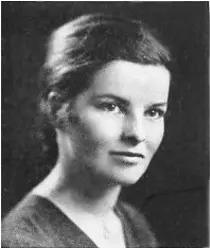
Hepburn’s yearbook photo, 1928, Bryn Mawr College (Wiki Image).
Katharine Hepburn’s path to becoming a legend began long before the cameras rolled. Here’s a glimpse into her formative years and the experiences that ignited her passion for acting:
A Family Rooted in Theater:
- Early Exposure: Born into a theatrical family in 1907, Hepburn was surrounded by the world of acting from a young age. Her parents, both involved in theater, nurtured her creative spirit.
- A Seed Planted: Watching her family’s involvement in theater likely sparked her own interest in performing, planting the seeds of her lifelong dream.
A Spirited Youth with a Passion for Performance:
- School Productions: Hepburn’s love for acting manifested early on. She actively participated in school plays, gaining experience and honing her skills on stage.
- Independent Spirit: Even as a youth, Hepburn displayed the strong will and independence that would become hallmarks of her acting career and public persona.
Formal Training and Early Steps on Stage:
- Seeking Refinement: After graduating high school, Hepburn set her sights on New York City, a hub for aspiring actors.
- Facing Setbacks: Despite her enthusiasm, she initially faced rejections from prestigious acting schools, who deemed her “not serious enough.”
- Finding Her Ground: Undeterred, Hepburn found opportunities in summer stock theater companies, gaining valuable experience in various roles and learning the craft from the ground up.
- Formal Education: She enrolled in acting schools like the John Murray Anderson/Robert Milton School of Theatre and Dance, further developing her acting skills alongside future Hollywood stars like Lucille Ball.
Setting Sights on Hollywood:
- The Allure of the Silver Screen: By the late 1920s, with a foundation of training and experience, Hepburn’s sights were set on Hollywood and film’s allure.
- Early Film Tests and Frustrations: She landed screen tests with studios like Universal Studios and eventually signed a contract. However, her initial film roles were small and stereotypical, yet they did not reflect the depth and complexity she craved.
Key Takeaways:
- A Nurturing Environment: Hepburn’s family background provided a supportive environment that fostered her love for theater.
- Early Performance Experiences: School plays and early-stage work gave her a platform to showcase her talent and develop her confidence.
- Resilience and Determination: Despite initial rejections, Hepburn’s persistence in pursuing training and opportunities laid the groundwork for her future success.
- A Bridge Between Stage and Screen: Her experience in theater provided a strong foundation for her transition to film acting in Hollywood.
Katharine Hepburn’s early life and stage beginnings reveal the dedication and perseverance required to pursue a career in acting. These formative years shaped her into a remarkable actress who would redefine the leading lady and leave an indelible mark on Hollywood history.
Hollywood Debut and Early Struggles
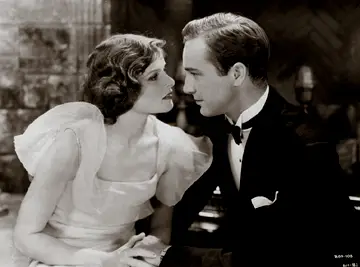
Hepburn’s first movie appearance was in the melodrama A Bill of Divorcement (1932). Critics praised her performance, and she became an instant star (Wiki Image).
Katharine Hepburn’s journey to Hollywood stardom wasn’t a smooth ride. Here’s a look at her ambitious beginnings and the challenges she faced:
Early Ambitions and a Spirited Entrance:
- Born into Privilege: Hepburn came from a theatrical family and strongly desired to act from a young age.
- Refusing the Mold: Unlike many actresses of the time, Hepburn rejected the stereotypical “flapper girl” roles offered to her, seeking characters with depth and substance.
Facing Rejection and Obstacles:
- Unconventional Beauty: Her strong features and independent spirit differed from what studios typically looked for in leading ladies. She was often told she looked “too intellectual” or “unfeminine.”
- Initial Setbacks: Despite her talent and determination, Hepburn faced numerous rejections and struggled to land significant roles in the early years.
Finding Her Footing on Stage:
- Stage Experience: While Hollywood could have been more readily welcoming, Hepburn succeeded on the East Coast theater scene.
- Critical Acclaim: Her performances garnered positive reviews, building her reputation as a talented and promising actress.
A Rocky Start in Hollywood:
- Breaking In: In 1932, Hepburn finally landed a contract with a major studio, RKO Pictures.
- A Disappointing Debut: While her first film, “A Bill of Divorcement” (1932), showcased her talent, it wasn’t a commercial success.
- The “Box Office Poison” Label: A string of commercially unsuccessful films, despite critical praise for her performances, led some to label her “box office poison.”
Turning Point and Rising Star:
- The Philadelphia Story (1940): This screwball comedy, based on a play Hepburn had previously performed on stage, became a major box office hit and critical darling.
- Redefining the Leading Lady: Hepburn’s portrayal of a strong, intelligent, and independent woman challenged Hollywood stereotypes and redefined the possibilities for leading female roles.
Key Takeaways:
- Perseverance and Unwavering Spirit: Hepburn’s early career was marked by resilience and a refusal to compromise on the roles she wanted to play.
- Stage Success Paves the Way: Her talent and experience on the stage helped her gain recognition and build a foundation for her Hollywood career.
- From Rejection to Redefining the Leading Lady: Despite initial setbacks, Hepburn’s determination and unique persona ultimately led her to become a Hollywood icon.
Hepburn’s early struggles highlight the challenges faced by actresses who dared to be different. Her journey from a headstrong newcomer to a force to be reckoned with is a testament to her talent, her unwavering spirit, and her lasting impact on Hollywood.
“A Bill of Divorcement” (1932) opposite John Barrymore.
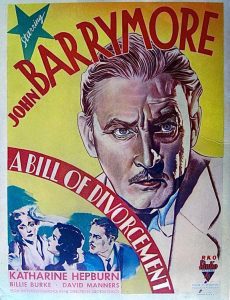
(Wiki Image).
- “There’s something wrong with Daddy. He doesn’t care about anything anymore.” – Ruth (Katharine Hepburn), expressing her concern about her father’s emotional withdrawal.
- “Men have to be strong, Ruth. They can’t break down.” – Hilary (John Barrymore), reflecting on the societal expectations of masculinity that prevent him from showing vulnerability.
- “I never meant to hurt you, but you wouldn’t let me help you.” – Fanny (Billie Burke) to Hilary, highlighting their marriage’s lack of communication and emotional intimacy.
- “I’m beginning to think there’s no such thing as a happy marriage.” Ruth is disillusioned by her parents’ relationship and questions the possibility of lasting love.
- “Sometimes you have to let go of the past to move on.” is a potential interpretation of the film’s message, suggesting the importance of forgiveness and accepting the reality of a broken situation.
Here are some details and quotes related to “A Bill of Divorcement” (1932):
Plot:
The film centers on the Fairfield family. Their seemingly perfect world crumbles when Ruth (Katharine Hepburn), the daughter, returns home from studying abroad to find her parents, Hilary (John Barrymore) and Fanny (Billie Burke), estranged.
A successful lawyer, Hilary has become emotionally distant and preoccupied with his work. He blames his wife, Fanny, for their son’s mental breakdown and subsequent institutionalization. Ruth attempts to reconcile her parents and understand the truth behind the family’s fractured relationships.
Themes:
- The devastating impact of mental illness on families.
- The breakdown of communication and lack of emotional support within a marriage.
- The societal expectations of masculinity and the pressure to appear strong lead to the suppression of emotions.
- The burden of societal expectations placed upon women and the challenges of finding happiness within a loveless marriage.
Interesting Facts:
- The film is based on a British play of the same name, which was a reaction to a law change allowing women to divorce their husbands on the grounds of insanity.
- Katharine Hepburn’s strong performance as Sydney launched her film career.
- The film was remade in 1940 with a slightly different storyline.
Would you like to know more about the characters, the critical reception of the film, or where you might be able to watch it?
“Morning Glory” (1933)
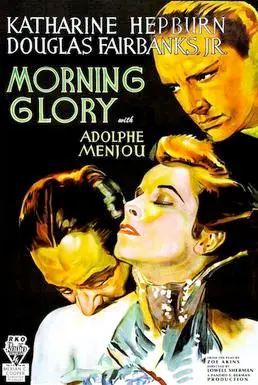
(Wiki Image).
- Eva Lovelace (Katharine Hepburn): “New York, here I come! Get ready for Eva Lovelace!” (This conveys Eva’s ambition and determination upon arriving in the city)
- Joseph Sheridan (Douglas Fairbanks Jr.): “There’s a spark in you, kid. But Broadway can chew you up and spit you out.” (This highlights Sheridan’s recognition of Eva’s potential while also warning her of the industry’s harsh realities)
- Eva Lovelace: “I don’t care if I scrub floors for a living, as long as I’m here, in New York!” (This emphasizes Eva’s unwavering commitment to her dream, even if it means facing hardship)
- Supporting character (paraphrased): “The theater is a fickle mistress. One night you’re a nobody, the next you’re a star.” (This reflects the unpredictable and competitive nature of the theater world)
- Eva Lovelace (paraphrased): “Fame is a double-edged sword. It gives you everything you ever wanted, but it takes something away too.” (This hints at the potential downsides of success that Eva might encounter)
Morning Glory (1933) – Katharine Hepburn
(YouTube video)
Morning Glory (1933) is a classic American pre-code drama film about an aspiring actress, Eva Lovelace (played by Katharine Hepburn), who arrives in New York City with dreams of making it big on Broadway. The film follows her journey as she navigates the cutthroat world of theater, facing rejection and setbacks.
Hepburn’s portrayal of the determined and ambitious Eva earned her critical acclaim and her first Academy Award for Best Actress. The film also stars Douglas Fairbanks Jr. and Adolphe Menjou.
Here’s a quick summary of the plot:
- Eva Lovelace, a small-town girl with big dreams, arrives in New York City determined to become a star.
- She faces numerous rejections and struggles to get her foot in the door.
- Eva eventually catches the eye of powerful theater producer Joseph Sheridan (played by Douglas Fairbanks Jr.), who sees her potential.
- She is allowed to audition for a role in a new play, but the competition is fierce.
- With Sheridan’s guidance and support, Eva lands the role and becomes an overnight sensation.
- However, as Eva’s stardom grows, she must grapple with the challenges of fame and the sacrifices it demands.
“Morning Glory” is a timeless story about ambition, perseverance, and pursuing one’s dreams. It’s a must-see for any fan of classic Hollywood films or Hepburn’s iconic performances.
The film was a critical and commercial success, and it is considered to be one of Hepburn’s best films. It was also remade in 1958 as “Stage Struck.”
Katharine Hepburn’s Rebirth as a Star
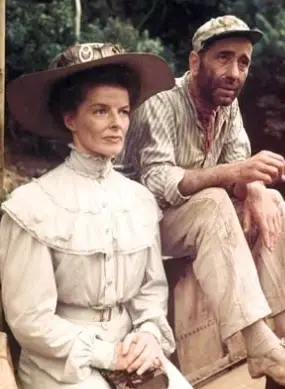
Hepburn often worked abroad in the 1950s, beginning with The African Queen with co-star Humphrey Bogart (Wiki Image).
While the term “rebirth” might be a bit strong, Katharine Hepburn’s career did experience a significant turning point in the late 1940s and into the 1950s. Here’s a breakdown of this period:
Box Office Decline and “Box Office Poison” Label:
- Early Success: Throughout the 1930s, Hepburn was a major box office draw, known for her independent spirit roles in films like “The Philadelphia Story” (1940) and “Woman of the Year” (1942).
- Shifting Audience Preferences: As World War II ended and Hollywood entered a new era, audience tastes shifted towards lighter fare and more traditional female characters.
- A String of Flops: Though critically acclaimed, some of Hepburn’s post-war film choices underperformed at the box office. This led some in the industry to label her “box office poison.”
Taking Control and Redefining Her Image:
- Independent Productions: Frustrated by the lack of strong roles offered by major studios, Hepburn formed her own production company and sought out projects that allowed her to showcase her talent.
- The Philadelphia Story Remake: In a bold move, Hepburn bought the rights to the play that launched her career, “The Philadelphia Story,” and remade it for the screen as “The African Queen” (1951).
The African Queen (1951) and Critical Acclaim:
- A Career-Defining Role: Hepburn’s portrayal of a headstrong missionary opposite Humphrey Bogart in “The African Queen” was a critical and commercial success.
- Award Recognition: She earned her second Academy Award for Best Actress for the role, proving her talent and defying the “box office poison” label.
A Second Chapter and Enduring Legacy:
- Continued Success: “The African Queen” marked a turning point, leading to a string of successful films for Hepburn throughout the 1950s and beyond, like “The Lion in Winter” (1968) and “On Golden Pond” (1981).
- Versatility and Longevity: Hepburn’s later career showcased her remarkable range, from fierce characters to more vulnerable roles, solidifying her status as a legend.
Key Takeaways:
- A Period of Reinvention: The late 1940s and 1950s weren’t strictly a “rebirth” but a time for Hepburn to adapt and redefine her career path.
- Taking Control and Embracing Challenges: By forming her own production company and seeking out unconventional roles, Hepburn took control of her career and proved her enduring talent.
- A Legacy of Strength and Versatility: This period solidified Hepburn’s reputation as a powerful actress who could captivate audiences with her intelligence, wit, and ability to portray complex characters.
“Bringing Up Baby” (1938), which he starred in alongside Cary Grant.

(Wiki Image).
- “Elysian Fields! That’s where the stegosaurus lives!” – Susan’s nonsensical yet endearing attempt to point David in the right direction.
- “You know, Miss Vance, you’re the most terrifyingly exhilarating woman I’ve ever met!” – David, flustered yet intrigued by Susan’s chaotic energy.
- “Honestly, Susan, you ought to be spanked!” – David’s frustrated yet playful response to Susan’s antics.
- “Well, one thing’s for sure. I’ll never be bored.” With Susan, David acknowledges his life’s unpredictable nature, hinting at a newfound appreciation for excitement.
- “You see, Mr. Huxley, my mother used to say, ‘If you don’t know where you are, it’s fun to pretend.'” Susan’s philosophy reflects the film’s embrace of spontaneity and lightheartedness.
“Bringing Up Baby” (1938) is a screwball comedy film known for its fast pace, witty dialogue, and wacky situations. Here’s a breakdown of this classic:
Plot:
Paleontologist David Huxley (Cary Grant) is a man of order and routine. His meticulously planned day is thrown into hilarious chaos when he encounters Susan Vance (Katharine Hepburn), a scatterbrained heiress with a pet leopard named Baby. Susan mistakes David for a zoologist and enlists him on a wild goose chase to retrieve a stolen dinosaur bone.
Their journey involves mistaken identities, romantic confusion, and a series of madcap situations, forcing David to abandon his uptight demeanor and embrace the absurdity.
Key Characters:
- David Huxley (Cary Grant): A befuddled paleontologist seeking funding for his museum. Initially uptight and easily flustered, he gradually loosens under Susan’s influence.
- Susan Vance (Katharine Hepburn) is a wealthy socialite with a zest for life and a penchant for mischief. She’s impulsive and adventurous and throws David into her chaotic world.
- Baby the Leopard: Susan’s mischievous pet who adds to the comedic mayhem.
Themes:
- The importance of letting go and embracing spontaneity.
- The clash between order and chaos, with chaos ultimately proving to be more liberating.
- The exploration of gender roles, with Susan challenging societal expectations of a proper lady.
- The power of attraction and the development of love through shared experiences, even if those experiences are absurd.
“The Philadelphia Story” (1940)
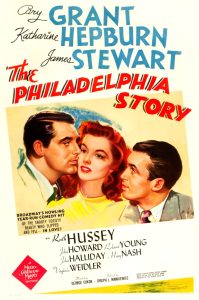
(Wiki Image).
- “Dexter, haven’t you heard? I’m cold, clear, and calculating.” – Tracy, initially portraying a facade of indifference towards her ex-husband.
- “The trouble with you, Tracy, is that in your heart you want to be a kitchen utensil.” – C.K., criticizing Tracy’s desire for a more conventional life.
- “Maybe some of us aren’t meant to settle down and be quilted.” – Tracy, expressing her fear of losing her independence in marriage.
- “I wouldn’t mind if you fell in love with me, Mr. Connor. As a matter of fact, I think I’d rather enjoy it.” Tracy hints at her growing feelings for the reporter.
- “Second marriages are like old shoes. They’re more comfortable but never quite as exciting.” – C.K., offering a playful yet insightful observation.
“The Philadelphia Story” (1940) is a classic screwball comedy known for its witty dialogue, romantic entanglements, and strong performances. Here’s a closer look:
Plot:
Tracy Lord (Katharine Hepburn), a wealthy socialite, is preparing for her second marriage to the uptight and boring George Kittredge (John Howard). However, her well-ordered world is disrupted by the arrival of her charming ex-husband, C.K. Dexter Haven (Cary Grant), and a cynical tabloid reporter, Macaulay Connor (James Stewart).
C.K. reignites old feelings and exposes Tracy’s insecurities about her upcoming marriage. Meanwhile, Connor, initially drawn to covering the society wedding, falls for the complex and captivating Tracy.
Key Characters:
- Tracy Lord (Katharine Hepburn): A strong-willed and independent woman with a sharp wit. Despite her initial coldness, she grapples with lingering feelings for her ex-husband.
- C.K. Dexter Haven (Cary Grant): Tracy’s charismatic ex-husband, a playboy with undeniable charm. He challenges Tracy and exposes her vulnerabilities.
- George Kittredge (John Howard): Tracy’s fiancé, a wealthy and reliable man, but lacking in excitement and passion.
- Macaulay Connor (James Stewart): A cynical reporter who softens as he gets to know Tracy and questions his initial assumptions.
Themes:
- The complexities of love and relationships, particularly the challenges of moving on from past love.
- The importance of self-discovery and finding personal fulfillment.
- The clash between social expectations and individual desires.
- The power of wit and humor in navigating complex situations.
“Woman of the Year” (1942)
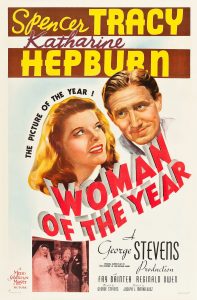
(Wiki Image).
- “I wouldn’t mind cooking dinner for a man once in a while, but I can’t very well do it if I’m not there.” – Tess, highlighting the difficulty of juggling domesticity with a demanding career.
- “Don’t you think a woman can be successful and still be feminine?” – Tess, challenging Sam’s outdated views on gender roles.
- “Maybe love isn’t all sunshine. Maybe it’s a little rough and tumble too.” – Sam, acknowledging the complexities and challenges of love.
- “I’m a woman in love with a man. And I happen to be a woman who also has an important job to her.” – Tess, voicing her desire for a relationship that supports her professional aspirations.
- “Marriage isn’t an arrangement—it’s a duel.” This witty line from the film reflects the playful tension and power struggles within their relationship.
“Woman of the Year” (1942) is a romantic comedy-drama starring Katharine Hepburn and Spencer Tracy. It’s a delightful and witty film that explores gender roles, career aspirations, and the challenges of balancing love and professional success.
Plot:
Tess Harding (Katharine Hepburn) is a strong-willed and fiercely intelligent foreign affairs correspondent on the rise. When she’s awarded “Woman of the Year,” she catches the eye of Sam Craig (Spencer Tracy), a sportswriter with traditional values who believes a woman’s place is in the home.
Their initial dislike for each other gradually turns into a passionate romance. However, Tess’ demanding career and commitment to her work creates friction in their relationship. Sam feels neglected and struggles to find his place in Tess’ fast-paced world.
Key Characters:
- Tess Harding (Katharine Hepburn): A dedicated journalist with a strong work ethic and fierce independence. She’s passionate about her career and unafraid to challenge societal expectations.
- Sam Craig (Spencer Tracy): A down-to-earth sportswriter who values tradition and domesticity. He feels threatened by Tess’ ambition and success.
Themes:
- The changing roles of women in society, particularly in the workplace.
- The challenges of balancing career aspirations with maintaining a fulfilling relationship.
- The importance of communication and compromise in a partnership.
- The power of love and mutual respect to overcome differences.
“The African Queen” (1951)
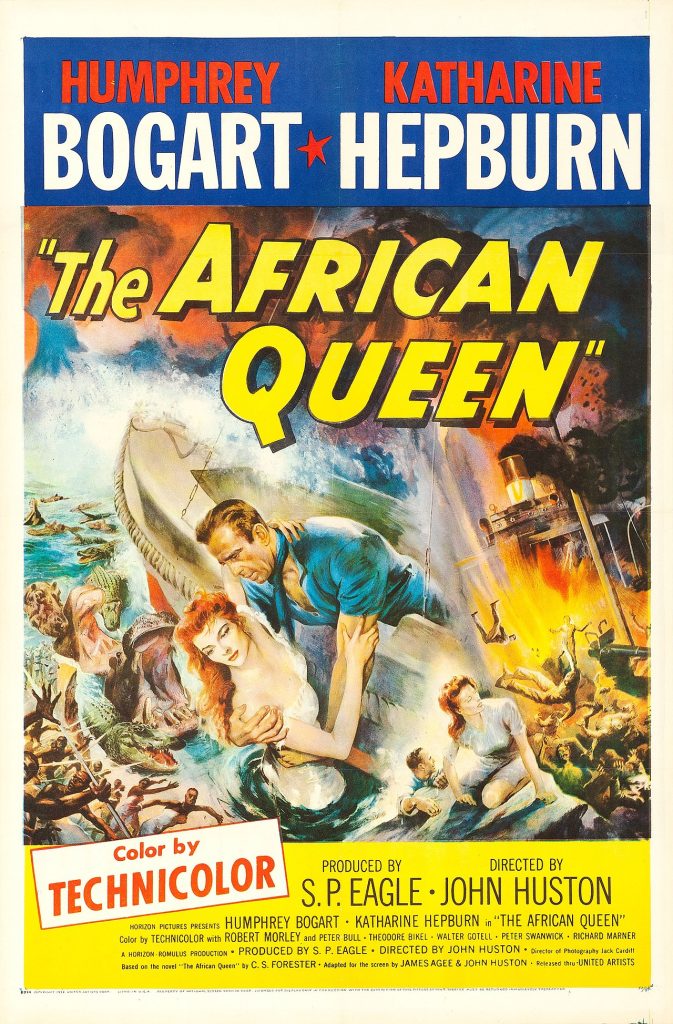
(Wiki Image).
- “Maybe God isn’t so interested in geography,” Rose questions her faith after the destruction caused by the war.
- “Get yourself a bloody good grip, Miss Missionary. We’re in the middle of bloody nowhere, surrounded by bloody Germans!” – Charlie, highlighting the dangerous situation they’re in.
- “All this because of a bit of tin whistle?” – Charlie, initially motivated by self-interest, gradually becomes invested in Rose’s mission.
- “Nature, Mr. Allnut, is what we are put in this world to resist.” – Rose, clinging to her principles despite their hardships.
- “Maybe it’s not such a bad thing to be stranded here with you after all.” Rose acknowledges her changing feelings toward Charlie.
“The African Queen” (1951) is a classic adventure film based on the 1935 novel by C.S. Forester. Here’s a breakdown of this exciting story set against the backdrop of World War I:
Plot:
The film takes place in German East Africa at the outbreak of WWI. Rose Sayer (Katharine Hepburn), a prim and proper missionary, is devastated by her brother’s death at the hands of German troops. She encounters Charlie Allnut (Humphrey Bogart), a gruff and gin-soaked riverboat captain.
Initially reluctant, Charlie agrees to take Rose down the treacherous Ulanga River so she can reach safety. However, Rose, fueled by vengeance, hatches a daring plan to sink a German warship, the Königin Luise, with a homemade torpedo.
Characters:
- Rose Sayer (Katharine Hepburn): A sheltered missionary thrust into a dangerous situation. Despite her initial propriety, she demonstrates resourcefulness and courage throughout the journey.
- Charlie Allnut (Humphrey Bogart): A cynical and world-weary riverboat captain. His initial reluctance to help Rose softens as they overcome challenges together.
Themes:
- The power of human connection and the ability to find strength in adversity.
- Unexpected love blossoms in a harsh environment.
- The transformation of individuals under pressure.
- The resilience of the human spirit in the face of war and danger.
- The blurred lines between civilization and savagery during wartime.
Memorable Moments:
- The banter and growing respect between the initially incompatible Rose and Charlie.
- Their perilous journey down the African River was filled with wildlife encounters and mechanical troubles.
- The suspenseful climax as they attempt to sink the German warship with their makeshift torpedo.
Critical Reception:
“The African Queen” was a critical and commercial success. It earned praise for its performances, particularly Humphrey Bogart’s Oscar-winning portrayal of Charlie Allnut. The film’s direction, cinematography, and depiction of adventure in the African landscape were also lauded.
Legacy:
“The African Queen” remains a beloved classic, remembered for its compelling story, iconic characters, and timeless themes. It continues to be celebrated for exploring human nature, survival, and the transformative power of love.
Katharine Hepburn’s Later Career: A Continued Journey of Strength and Versatility
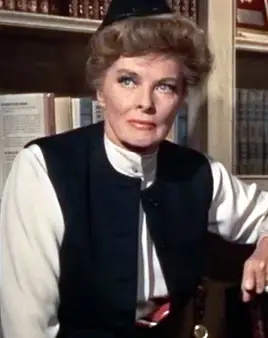
In Guess Who’s Coming to Dinner (1967), which won Hepburn her second of four Academy Awards (Wiki Image).
While Katharine Hepburn’s reign as a top box office star may have waned in the 1940s, her later career displayed remarkable resilience and a continued commitment to pushing boundaries. Here’s a closer look at this chapter of her remarkable journey:
Shifting Focus:
- Transition to Character Roles: As leading lady roles became less frequent, Hepburn embraced character parts, showcasing her remarkable versatility.
- Stage and Television: She found success on the stage and embraced the emerging medium of television, winning an Emmy Award for her performance in “Strangers: The Story of a Mother and Daughter” (1979).
Memorable Performances:
- Golden Years Legacy: Hepburn continued to deliver powerful performances in films like “The Lion in Winter” (1968), which earned her a third Academy Award for Best Actress.
- Later Career Highlights: She captivated audiences with her portrayal of a headstrong missionary in “The African Queen” (1951) and a heartwarming connection with a younger generation in “On Golden Pond” (1981), which garnered her a record-breaking fourth Academy Award for Best Actress.
Embracing Challenges:
- Taking Risks: Hepburn never shied away from challenging roles, even tackling Shakespearean characters on stage well into her later years.
- Breaking Barriers: She continued to advocate for strong female characters at a time when Hollywood offered fewer such opportunities for older actresses.
Key Takeaways:
- Adaptability and Growth: Hepburn’s later career demonstrates her ability to adapt and thrive in a changing industry.
- Enduring Talent: Her dedication to her craft and captivating presence remained undimmed throughout her later years.
- A Role Model for Aging Actresses: Hepburn defied stereotypes about aging in Hollywood, proving that actresses could continue to deliver powerful performances well into their later years.
Additional Points to Consider:
- Continued Collaboration: She reunited with her longtime screen partner Spencer Tracy in “Guess Who’s Coming to Dinner” (1967), further solidifying their legendary screen chemistry.
- Personal Struggles: Hepburn faced personal challenges, including the loss of Tracy, but continued to work despite them.
- Maintaining Independence: She fiercely guarded her privacy and controlled her career choices.
Katharine Hepburn’s later career is an inspiring testament to her unwavering dedication to her craft, refusal to be typecast, and ability to adapt and thrive throughout her long and remarkable acting journey.
“Guess Who’s Coming to Dinner” (1967)
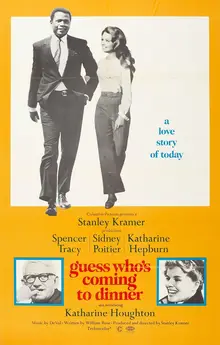
(Wiki Image).
- “It seems to me without your approval we would make no sense at all.” – Dr. John Prentice to Matt Drayton, highlighting the importance of parental acceptance.
- “You see yourself as a colored man; I see myself as a man.” – Dr. John Prentice to his father, challenging racial labels.
- “We’re going to have grandchildren who are plaid!” – Christina Drayton, using humor to address the concept of a mixed-race family. [This quote might be considered insensitive today, so you might suggest omitting it or using a bracketed note to indicate that the humor reflects the social norms of the time]
- “There’s a lot of water under the bridge, but you can’t just wash it all away.” – Matt Drayton, acknowledging the difficulty of changing ingrained beliefs.
- “Guess what? It’s gonna work. It has to work.” – Christina Drayton, expressing her determination to support her daughter’s marriage.
GUESS WHO’S COMING TO DINNER [1967] – Official Trailer (HD)
(YouTube video)
“Guess Who’s Coming to Dinner” (1967) is a landmark film that tackles the sensitive topic of interracial marriage in a comedic and thought-provoking way. Here’s a closer look:
Plot:
Joanna (Katharine Houghton), a young white woman, returns home from Hawaii with her fiancé, Dr. John Prentice (Sidney Poitier), a distinguished black man. The news initially shocked her liberal-minded parents, Matt Drayton (Spencer Tracy) and Christina Drayton (Katharine Hepburn).
While Christina seems more accepting, Matt grapples with his internal biases and worries about the challenges the couple will face due to societal prejudice. The film explores the anxieties and mixed emotions surrounding the upcoming marriage as both families meet for the first time.
Characters:
- Joanna Drayton (Katharine Houghton): A strong-willed young woman confident in her choice to marry John.
- Dr. John Prentice (Sidney Poitier): A successful and intelligent doctor who faces societal prejudice despite his accomplishments.
- Matt Drayton (Spencer Tracy): A well-meaning publisher who struggles with his own ingrained biases.
- Christina Drayton (Katharine Hepburn): A sophisticated and open-minded art gallery owner who is more accepting of the relationship.
Themes:
- Interracial Marriage: The film explores the challenges and prejudices faced by interracial couples in the 1960s.
- Family Dynamics: The film sheds light on the complexities of family relationships and the importance of acceptance.
- Tolerance: The film promotes tolerance and understanding towards people of different races.
- Love and Commitment: Despite the challenges, the film ultimately celebrates the power of love and commitment.
“The Lion in Winter” (1968)
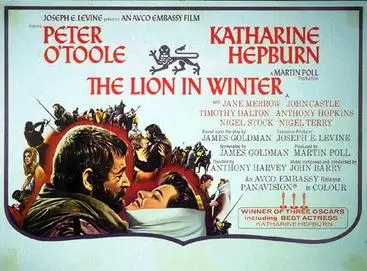
(Wiki Image).
- “Don’t touch me! You touch me, and you’ll stink of defeat.” – King Henry, highlighting his fear of weakness and mortality.
- “A queen, rightfully out of place, is a dangerous thing to behold.” – Eleanor, showcasing her strength and defiance despite imprisonment.
- “You want a kingdom? Earn it!” – King Henry, emphasizing the challenges and burdens of leadership.
- “I will not be tamed! I am a lioness!” – Eleanor, refusing to submit to her husband’s control.
- “I know you. You are a devious and dangerous woman. But God help me, I love you.” – King Henry, expressing his conflicting emotions towards Eleanor.
The Lion in Winter 1968 Trailer | Peter O’Toole | Katharine …
(YouTube video)
Absolutely. “The Lion in Winter” (1968) is a historical drama that delves into the power struggles and family tensions within King Henry II of England’s royal court.
Plot:
The film takes place in 1183 AD during Christmas celebrations. King Henry II (Peter O’Toole), nearing the end of his reign, is seeking an heir to succeed him on the throne. He summons his estranged wife, Queen Eleanor of Aquitaine (Katharine Hepburn), who has been imprisoned for ten years, and their three sons: Richard (Anthony Hopkins), Geoffrey (Nigel Terry), and John (John Castle).
Each son has his ambitions and alliances, and they all maneuver and manipulate to gain their father’s favor. The film explores the complex web of relationships, filled with love, hate, betrayal, and a thirst for power.
Characters:
- King Henry II (Peter O’Toole): An aging and manipulative king who enjoys playing his sons against each other to maintain control.
- Queen Eleanor of Aquitaine (Katharine Hepburn): A strong-willed and intelligent woman, still bitter about her imprisonment but determined to reclaim her influence.
- Richard (Anthony Hopkins): The eldest son, a brave warrior but considered too impulsive by his father.
- Geoffrey (Nigel Terry): The middle son, cunning and ambitious but lacking the strength to rule.
- John (John Castle): The youngest and most ruthless son, favored by the king but despised by his brothers.
Themes:
- Family Dynamics: The film portrays the destructive nature of family power struggles and the lengths people go for power and inheritance.
- Love and Betrayal: Despite their conflicts, the film explores the complex and enduring love between Henry and Eleanor and the betrayals they inflict upon each other and their sons.
- Aging and Mortality: King Henry grapples with his declining health and the question of his legacy.
- Power and Politics: The film depicts the ruthless world of medieval politics, where loyalty is fleeting, and alliances shift for personal gain.
“On Golden Pond” (1981)
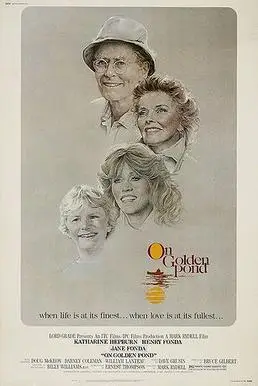
(Wiki Image).
- “You know, Ethel, we’ve had a good life together. Don’t you think?” – Norman, expressing gratitude for his life and his wife.
- “The heart doesn’t grow old, Ethel. It just loses its bearings sometimes.” – Norman, reflecting on the emotional challenges of aging.
- “You can’t just shut people out of your life, Chelsea. Not even your father.” Ethel urges her daughter to forgive Norman.
- “Maybe all one can do is hope to end up with the right person sitting beside them.” – Norman, contemplating the importance of relationships.
- “I love you, Dad.” Chelsea finally expresses her love for her father in a moment of reconciliation.
On Golden Pond (1981) ORIGINAL TRAILER
(YouTube video)
Here’s a breakdown of “On Golden Pond” (1981), the heartwarming drama starring Katharine Hepburn and Henry Fonda:
Plot:
A retired professor, Norman Thayer (Henry Fonda), spends summers with his wife, Ethel (Katharine Hepburn), at their Golden Pond cottage. This year, their idyllic routine is disrupted by the arrival of their estranged daughter, Chelsea (Jane Fonda), along with her fiancé, Bill (Dabney Coleman), and his teenage son, Billy (Doug McKeon).
Norman is grumpy and struggles with his aging body and fading memory. Chelsea harbors resentment towards her father for his past emotional neglect. The film explores themes of family reconciliation, acceptance of aging, and the importance of cherishing loved ones. As Norman bonds with Billy, he grapples with his mortality and tries to mend his relationship with Chelsea.
Characters:
- Norman Thayer (Henry Fonda): A curmudgeon nearing the end of his life, struggling with his declining health and longing for connection.
- Ethel Thayer (Katharine Hepburn): Norman’s loving and supportive wife, who helps him navigate his anxieties and maintains a positive outlook.
- Chelsea Thayer (Jane Fonda): Norman and Ethel’s daughter, harboring unresolved anger towards her father for his past emotional distance.
- Billy Ray (Doug McKeon): Bill’s teenage son, a kind and open-hearted young man who forms an unexpected bond with Norman.
- Bill Ray (Dabney Coleman): Chelsea’s self-absorbed fiancé who creates tension within the family dynamic.
Themes:
- Family Reconciliation: The film explores the complexities of family relationships and the challenges of forgiveness and acceptance.
- Aging: The film portrays the physical and emotional challenges with honesty and sensitivity.
- Importance of Connection: The film emphasizes the importance of human connection and cherishing loved ones in the face of mortality.
- Letting Go: The film explores the concept of letting go of past hurts and embracing the present.
Katharine Hepburn’s Impact on Cinema: A Legacy of Strength and Independence
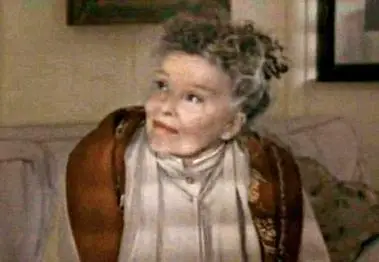
Hepburn’s final film role was in Love Affair (1994). Critics commented that the 87-year-old had lost none of her powerful screen presence (Wiki Image).
Katharine Hepburn’s influence on cinema transcends her numerous awards and box office successes. She left an indelible mark on the screen by portraying strong, independent women, defying stereotypes, and paving the way for generations of actresses.
Breaking the Mold:
- Challenging the “Good Girl” Image: Hepburn rejected the typical Hollywood damsel-in-distress roles, opting for characters with intelligence, wit, and a fierce spirit.
- Embracing Complexity: She wasn’t afraid to play flawed or unconventional women, bringing depth and nuance to her performances.
- Fashion Iconoclast: Hepburn’s signature style, often favoring pants and tailored suits, challenged traditional notions of femininity in Hollywood.
A Voice for Women:
- Empowering Characters: She brought to life characters who challenged societal expectations for women, inspiring audiences to redefine femininity and pursue their ambitions.
- Off-Screen Activism: Hepburn advocated for equal rights for women and championed social causes, aligning her onscreen persona with her real-life convictions.
- A Role Model: Hepburn’s long and successful career became a testament to a woman’s ability to thrive in Hollywood on her terms, inspiring future actresses to fight for better roles and recognition.
Lasting Influence:
- Opening Doors: Hepburn’s success opened doors for a wider range of female characters in film, paving the way for more complex and realistic portrayals of women.
- A Standard for Excellence: Her dedication to her craft and commitment to portraying strong, intelligent women set a high bar for acting, influencing generations of performers.
- Enduring Legacy: Hepburn’s films continue to be studied and admired for their timeless themes, captivating performances, and enduring screen presence.
Additional Points to Consider:
- Box Office Success: Despite breaking the mold, Hepburn was a box office draw, proving that strong female characters could resonate with audiences.
- Collaboration with Spencer Tracy: Her on-screen partnership with Spencer Tracy is considered one of Hollywood’s greatest, showcasing a dynamic tension between strong personalities.
- Versatility: While known for her independent spirit roles, Hepburn also excelled in period dramas and romantic comedies, showcasing her range as an actress.
Katharine Hepburn’s impact extends far beyond the silver screen. She challenged societal norms, redefined femininity in Hollywood, and inspired generations of women to be bold and independent. Her legacy lives on in the enduring power of her performances and the blueprint she laid for strong female characters in cinema.
Bette Davis: The Firebrand of Hollywood’s Golden Age
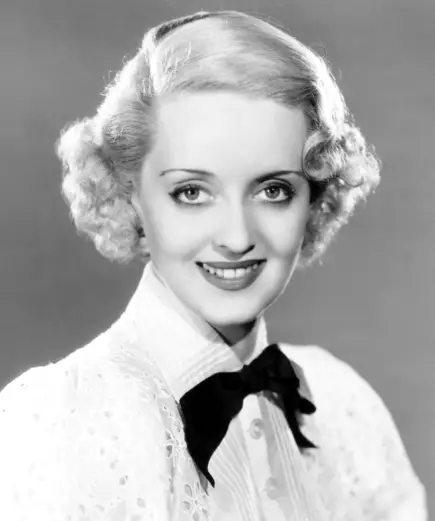
Davis in 1935 (Wiki Image).
Born April 5, 1908, Lowell, Massachusetts, U.S.
Died October 6, 1989 (aged 81) Neuilly-sur-Seine, France
| Year | Movie Title | Role | Notes |
|---|---|---|---|
| 1931 | Bad Sister | Laura Madison | Film Debut |
| 1932 | The Man Who Played God | Grace Blair | Early Success |
| 1934 | Of Human Bondage | Mildred Rogers | Critical acclaim, write-in Oscar votes |
| 1935 | Dangerous | Joyce Heath | Won Academy Award for Best Actress |
| 1936 | The Petrified Forest | Gabrielle Maple | Co-starring Leslie Howard |
| 1937 | Marked Woman | Mary Dwight Strauber | |
| 1938 | Jezebel | Julie Marsden | Won Academy Award for Best Actress |
| 1939 | Dark Victory | Judith Traherne | Nominated for Academy Award (Best Actress) |
| 1940 | The Letter | Leslie Crosbie | Nominated for Academy Award (Best Actress) |
| 1941 | The Little Foxes | Regina Giddens | Nominated for Academy Award (Best Actress) |
| 1942 | Now, Voyager | Charlotte Vale | Nominated for Academy Award (Best Actress) |
| 1943 | Watch on the Rhine | Sara Muller | |
| 1944 | Mr. Skeffington | Fanny Trellis Skeffington | Nominated for Academy Award (Best Actress) |
| 1946 | A Stolen Life | Kate and Patricia Bosworth | Dual role |
| 1949 | Beyond the Forest | Rosa Moline | “What a dump!” |
| 1950 | All About Eve | Margo Channing | Nominated for Academy Award (Best Actress) |
| 1952 | The Star | Margaret Elliot | |
| 1955 | The Virgin Queen | Queen Elizabeth I | |
| 1959 | John Paul Jones | Catherine the Great | |
| 1962 | What Ever Happened to Baby Jane? | Baby Jane Hudson | Nominated for Academy Award (Best Actress) |
| 1964 | Dead Ringer | Edith Phillips and Margaret DeLorca | Dual Role |
| 1965 | The Nanny | Nanny | |
| 1978 | Death on the Nile | Marie Van Schuyler | |
| 1987 | The Whales of August | Libby Strong | Her final film role |
Bette Davis (1908-1989), born Ruth Elizabeth Davis, was a force to be reckoned with in Hollywood. Known for her powerful performances, fierce independence, and willingness to play complex characters, she became a legend of the Golden Age of cinema. Here’s a closer look at her remarkable journey:
Early Life and Theatrical Aspirations:
- Born in Lowell, Massachusetts, Davis developed a passion for acting at a young age.
- Despite initial rejections after graduating high school, she pursued acting training in New York City.
- Her determination landed her roles in summer stock theater productions.
Hollywood Breakthrough and Studio Battles:
- In 1930, Davis signed a contract with Universal Studios. However, her early films could have been more commercially successful.
- In 1932, Warner Bros. offered her a chance to play a headstrong waitress in “Of Human Bondage” (1934). This gritty role became her breakthrough performance, showcasing her raw talent and willingness to defy expectations.
- Despite critical acclaim, Davis clashed with the studio system over control of her career and the types of roles she was offered.
- This led to a well-publicized lawsuit in 1936, which she ultimately lost. However, it paved the way for more control over her acting choices in the future.
Golden Years and Enduring Impact:
- The late 1930s and 1940s were Davis’s golden years. She delivered iconic performances in a range of films, including:
- “Jezebel” (1938)
- “Dark Victory” (1939)
- “The Letter” (1940)
- “Now, Voyager” (1942)
- “Mr. Skeffington” (1944)
- These films showcased her versatility, allowing her to portray strong-willed women, villains, and even sympathetic characters.
- Though nominated for Best Actress ten times, Davis never won an Oscar. However, she did win an Academy Award for Best Supporting Actress in “Dangerous” (1935).
- Despite this, her impact on cinema remains undeniable.
Later Career and Legacy:
- Throughout the 1950s and 1960s, Davis continued to act in films and television, taking on challenging roles even as her career faced fluctuations.
- Her performance in “What Ever Happened to Baby Jane?” (1962) renewed her recognition and a younger generation of fans.
- Davis battled cancer later in life, never letting it diminish her spirit or passion for acting.
- She remains an inspiration for her fierce talent, dedication to her craft, and willingness to challenge stereotypes of femininity on screen.
Bette Davis’s legacy is that of a groundbreaking actress who pushed boundaries and redefined what it meant to be a leading lady. Her fiery performances and powerful presence continue to captivate audiences and inspire aspiring actors.
From Aspiring Actress to Hollywood Icon: Bette Davis’ Early Life and Theatrical Beginnings
Bette Davis, born Ruth Elizabeth Davis in 1908, had a spark for the stage that ignited early on. Here’s a look at her formative years and the experiences that shaped her journey to Hollywood stardom:
A Seed of Theatricality Planted Early:
- School Productions: While attending Cushing Academy in Massachusetts, Davis participated in school plays. This fueled her passion for acting and performing.
- Influential Inspiration: A pivotal moment came in 1926 when, at 18, she saw a production of Henrik Ibsen’s “The Wild Duck” starring Peg Entwistle. Davis later recalled Entwistle’s performance as the reason she wanted to pursue acting.
Seeking Training and Facing Rejection:
- Moving to New York: After graduating high school, Davis set her sights on New York City, the heart of American theater.
- Undeterred by Setbacks: She faced initial rejections from prestigious acting schools like Eva Le Gallienne’s The Theatre Guild, who deemed her “not serious enough.”
Finding Her Footing:
- Stock Theater: Determined to hone her craft, Davis found opportunities in summer stock theater companies, gaining valuable experience in various roles.
- John Murray Anderson/Robert Milton School of Theatre and Dance: She enrolled in this New York school alongside future Hollywood legend Lucille Ball, further developing her acting skills.
The Dream of Hollywood Beckons:
- Screen Tests and Early Film Projects: By the late 1920s, Davis began pursuing film roles. She landed a screen test with Universal Studios in 1930, eventually signing a contract.
- Hollywood Breakthrough Still Awaits: Her initial film roles were small and stereotypical, not yet reflecting the depth and complexity she craved.
Key Takeaways:
- Early exposure to theater: Experiences like school plays and seeing a captivating performance planted the seeds of her acting dream.
- Persistence and Determination: Davis faced rejections but never gave up on her passion, seeking training and opportunities.
- Building a Foundation: Stock theater provided valuable experience, and schools honed her skills, preparing her for the challenges ahead.
- Setting Sights on Hollywood: While Hollywood stardom wasn’t immediate, Davis focused on securing film roles.
Bette Davis’s early life highlights the dedication and perseverance required to pursue a career in acting. Her journey from aspiring actress to Hollywood icon is a testament to her unwavering passion and the experiences that shaped her into the legendary performer we know today.
Bette Davis’s Hollywood Breakthrough and Studio Battles: A Fiery Rise to Stardom
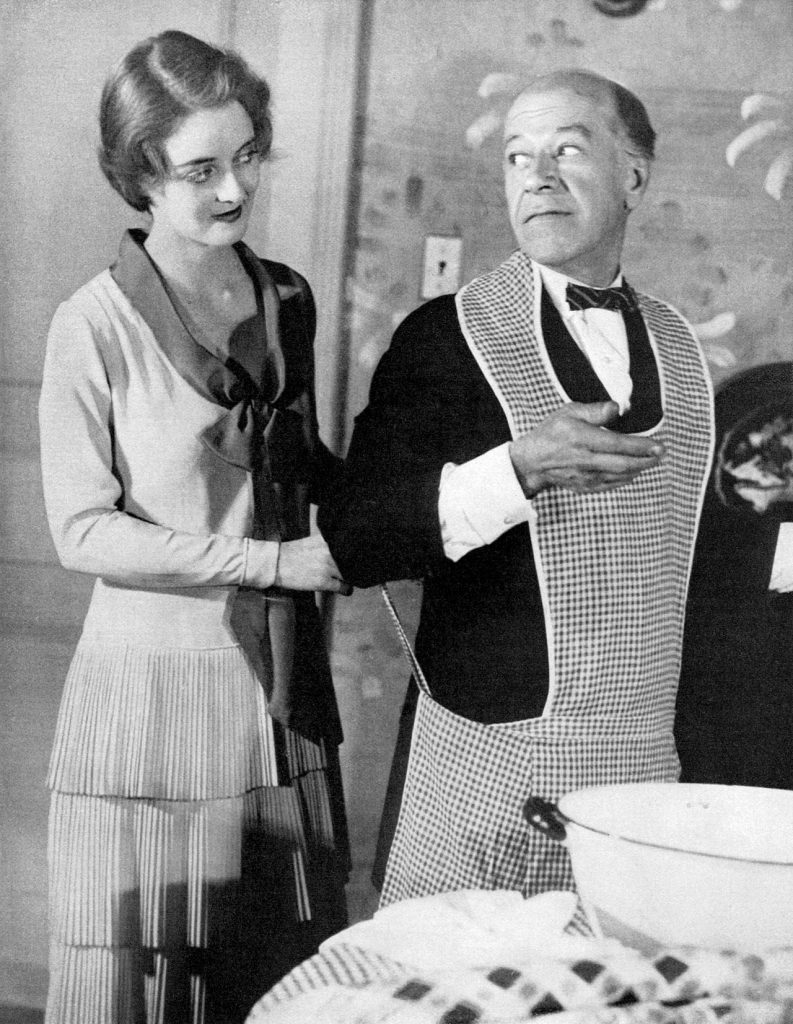
Bette Davis and Donald Meek in Broken Dishes (1929). “I was now a bona fide Broadway actress—in a hit,” Davis wrote (Wiki Image).
Bette Davis’s path to Hollywood stardom was paved with talent and tenacity. Here’s a look at her early struggles, breakthrough moment, and the battles she waged with the studio system:
Early Struggles:
- Breaking In: After graduating from drama school in 1928, Davis faced initial rejections due to her unconventional looks. Studios deemed her “too unattractive” for leading lady roles.
- Frustration with Stereotypes: She was often offered stereotypical “flapper girl” parts, which she found uninspiring and limiting.
- Universal Studios Loan-Out: In 1932, Universal Studios loaned Davis out to compete with a rising star at another studio, a common practice at the time.
Breakthrough with “Of Human Bondage” (1934):
- Defying Expectations: Davis landed the role of Mildred Rogers, a manipulative and unsympathetic character in “Of Human Bondage.”
- A Daring Performance: Her raw portrayal challenged the typical “good girl” image of leading ladies and captivated audiences.
- Critical Acclaim and Academy Award Nomination: Her performance garnered critical acclaim and earned her a coveted Academy Award nomination for Best Actress, marking a turning point in her career.
Studio Battles and Fighting for Control:
- Refusing Formulaic Roles: Davis clashed with Warner Bros., the studio that acquired her contract, for wanting to typecast her in similar unlikable roles.
- Fighting for Quality Scripts: She demanded control over her scripts and fought for roles with depth and complexity.
- Suspension and Public Feuds: Her defiance led to suspensions, public feuds with studio executives, and accusations of being “difficult.”
Impact and Legacy:
- A Star on Her Own Terms: Despite the battles, Davis emerged as a powerful actress with a reputation for demanding good material.
- Paving the Way for Others: Her fight for better roles paved the way for more complex female characters and empowered other actresses to fight for better opportunities.
- A Symbol of Strength and Independence: Davis became a symbol of strength and independence in a male-dominated industry.
Additional Points to Consider:
- The “Bette Davis Eyes”: Her piercing gaze and expressive eyes became a trademark, often used to portray strong-willed and complex characters.
- Multiple Academy Award Nominations: Throughout her career, Davis received a record ten Academy Award nominations for Best Actress, winning twice.
- A Long and Illustrious Career: Even after her “Golden Years” in the 1930s and 1940s, Davis continued to work for decades, showcasing her versatility in various roles.
Bette Davis’s story is one of talent, persistence, and a refusal to compromise on her artistic vision. She challenged the Hollywood studio system and emerged as a legendary actress who continues to inspire generations of performers and moviegoers today.
“Of Human Bondage” (1934)
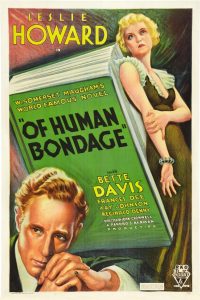
(Wiki Image).
- “Isn’t life a funny business? Just when you think you’ve got it all figured out, bang! Something hits you in the face.” – Philip, reflecting on the unexpected turns life can take.
- “I hate weak people. I hate myself for being weak.”—Philip, expressing his self-loathing and vulnerability to manipulation.
- “Sometimes you have to be cruel to be kind.” Mildred justifies her hurtful behavior by claiming to help Philip.
- “There’s more to life than chasing after a woman who doesn’t love you.” – Dr. Stevenson offering Philip wise advice.
- “Life isn’t all sunshine and roses.” This famous line from the film highlights life’s inevitable hardships and challenges.
“Of Human Bondage” (1934) is a drama film based on the novel of the same name by W. Somerset Maugham. Here’s a closer look:
Plot:
The film follows the story of Philip Carey (Leslie Howard), a sensitive and ambitious young man with a club foot deformity. He dreams of becoming a painter but lacks talent and struggles with self-doubt. He abandons his artistic aspirations and decides to pursue medicine.
During his studies, Philip becomes infatuated with Mildred Rogers (Bette Davis), a manipulative and cold waitress. Despite her cruel treatment, Philip becomes obsessed with her. Throughout the film, they enter into a destructive and on-again, off-again relationship that brings Philip much pain and suffering.
Characters:
- Philip Carey (Leslie Howard): A kind-hearted but insecure young man with artistic aspirations. His physical deformity and low self-esteem make him vulnerable to manipulation.
- Mildred Rogers (Bette Davis): A cynical and manipulative waitress who preys on Philip’s weaknesses. She offers him affection but ultimately cares more about her comfort and security.
- Rosie (Frances Dee): A kind and compassionate waitress who becomes Philip’s friend and confidante. She offers him genuine affection and support, a stark contrast to Mildred.
- Dr. Alec Stevenson (Kay Johnson): A wise and experienced doctor who mentors Philip and guides him throughout his medical studies.
Themes:
- Destructive Relationships: The film explores the dynamics of a toxic relationship and the emotional toll it takes on the characters.
- Self-discovery: Philip’s journey is self-discovery as he learns to accept his limitations and find his path in life.
- Overcoming Adversity: The film portrays Philip’s struggles with his physical deformity and his efforts to overcome his insecurities and self-doubt.
- The Power of Compassion: The film contrasts the destructive relationship with Mildred with the healing power of genuine compassion offered by Rosie and Dr. Stevenson.
Please note: The 1934 film adaptation differs from the novel in some aspects, particularly how it portrays Mildred’s character. The novel offers a more nuanced and tragic view of Mildred, while the film emphasizes her manipulative and cruel behavior.
Golden Years and Enduring Impact
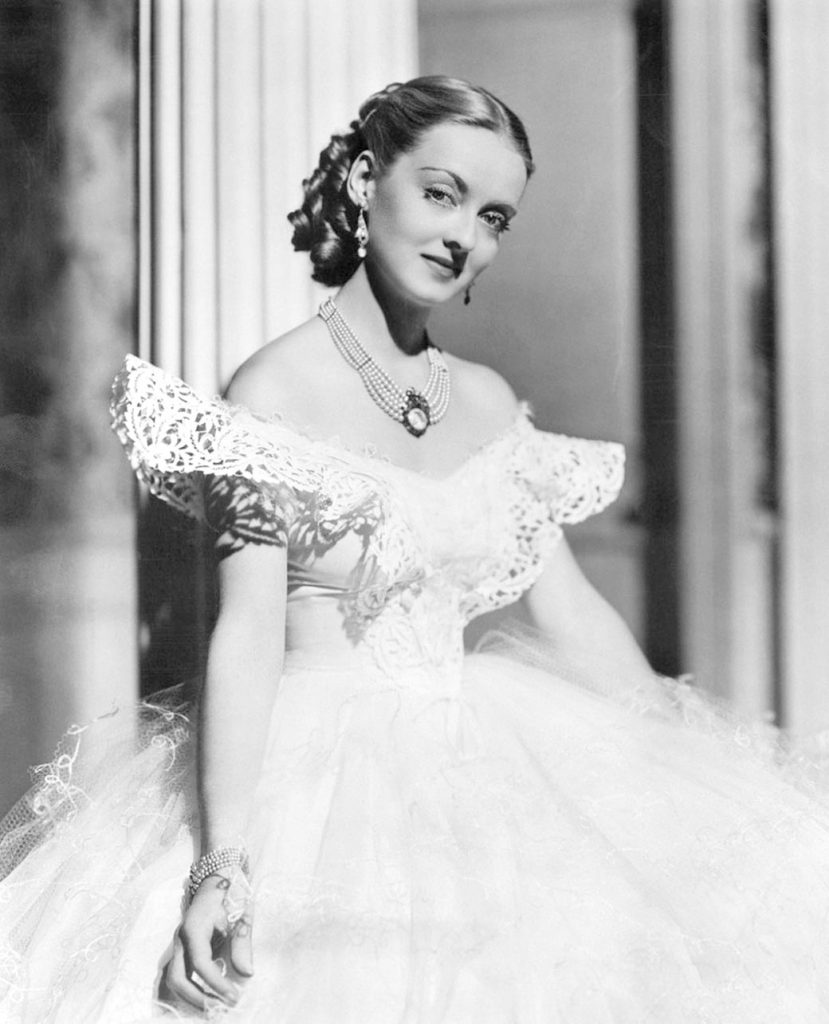
Davis in Jezebel (1938) (Wiki Image).
Bette Davis was a force of nature in Hollywood, particularly during her Golden Years in the 1930s and 1940s. Here’s a look at her reign and the lasting impact she left on cinema:
Golden Years: A Reign of Powerhouse Performances
- Breaking Stereotypes: Davis defied the norm by portraying complex, often unlikeable women. She wasn’t afraid to be vulnerable, manipulative, or even villainous. This challenged the typical “good girl” image of female leads at the time.
- Versatility: From fiery seductresses in “Jezebel” (1938) and “The Letter” (1940) to vulnerable souls in “Dark Victory” (1939) and “Now, Voyager” (1942), Davis displayed an unmatched range that captivated audiences.
- Box Office Domination: She was a major box office draw, starring in a string of successful films that cemented her status as a Hollywood A-lister.
- Award Recognition: Davis received ten Academy Award nominations for Best Actress, winning twice for “Dangerous” (1935) and “Jezebel” (1938). This is a record for most nominations in that category.
Impact That Continues to Resonate
- Paving the Way: Davis’s success opened doors for more complex female characters and empowered actresses to demand stronger roles.
- Inspiring Generations: Her dedication, talent, and outspoken personality continue to inspire actresses today.
- Enduring Performances: Her films remain classics, studied, and admired for their powerful storytelling and captivating performances.
- Iconic Status: Bette Davis is synonymous with Hollywood’s Golden Age. Her image, voice, and unforgettable characters are forever etched in cinema history.
Beyond the Golden Years:
- Transition and Continued Success: While her reign as a top box office star tapered in the 1950s, Davis remained active, transitioning to character roles and finding success on stage and television.
- Overcoming Challenges: She battled personal and professional challenges, including feuds with other stars and declining health. But she never lost her passion for acting.
Legacy Beyond Awards:
- Fierce Spirit: Davis’s tenacity and refusal to be typecast are as inspiring as her acting talent.
- A Symbol of Strength: She fought for what she believed in, both on and off screen, leaving a legacy of female empowerment.
Bette Davis wasn’t just a movie star but a cultural icon. Her impact on film transcends time, and her influence continues to shape the landscape of acting today. She is a reminder that powerful performances and a fierce spirit can leave an undeniable mark on the world.
“Dangerous” (1935)
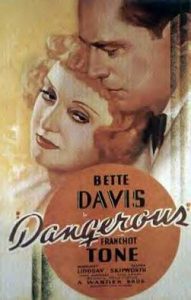
(Wiki Image).
‘Dangerous’ (1935) starring Bette Davis and Franchot Tone
(YouTube video)
- “Don’t you dare feel sorry for me! I wouldn’t give you the satisfaction.” – Joyce, showcasing her defensive and prideful nature despite her vulnerability.
- “I respect what you do, Denys, but I cannot live the life of a nomad.” – This line, spoken initially to Denys in “Out of Africa,” was perhaps misremembered. In “Dangerous,” a similar line might be spoken by Gail to Don when he becomes consumed by helping Joyce.
- “Maybe some people aren’t meant to be happy.” – Joyce, expressing her pessimism and belief that she is destined for failure.
- “I’m a has-been. Washed up. Finished.” – Joyce, struggling to accept her declining career and self-worth.
- “I’m in love with you, Joyce. But I can’t save you if you won’t let me.” – Don, expressing his love and frustration with Joyce’s resistance to help.
Absolutely, “Dangerous” (1935) is a dramatic film that skyrocketed Bette Davis to stardom and earned her the first of her two Academy Awards for Best Actress. Here’s a closer look:
Plot:
Don Bellows (Franchot Tone) is a successful architect engaged to the beautiful and wealthy Gail Armitage (Margaret Lindsay). His life takes an unexpected turn when he encounters Joyce Heath (Bette Davis), a down-and-out alcoholic actress with a talent for self-destruction.
Don feels a strange obligation towards Joyce, perhaps due to her past success that inspired his career path. He attempts to rehabilitate her, offering her financial support and a chance to get her career back on track. As Don helps Joyce, he becomes increasingly drawn to her volatile personality.
However, Joyce’s insecurities and self-sabotaging behavior threaten their progress. She pushes Don away and clings to her troubled past, including that of a vindictive ex-husband (John Eldredge). The film explores themes of addiction, redemption, and the complexities of love amidst personal demons.
Characters:
- Joyce Heath (Bette Davis): A talented but troubled actress battling alcoholism and self-doubt.
- Don Bellows (Franchot Tone): A successful and compassionate architect who becomes entangled with Joyce.
- Gail Armitage (Margaret Lindsay): Don’s beautiful and wealthy fiancé is left behind as he focuses on Joyce.
Themes:
- Addiction and Redemption: The film explores the challenges of overcoming addiction and the possibility of redemption for those struggling with self-destruction.
- Second Chances: The film examines the concept of giving someone a second chance and the potential consequences of such actions.
- Destructive Relationships: The film portrays the complexities of codependent relationships and the challenges of loving someone with self-destructive tendencies.
- The Price of Fame: The film explores the dark side of fame and its toll on an individual’s life.
“Jezebel” (1938)
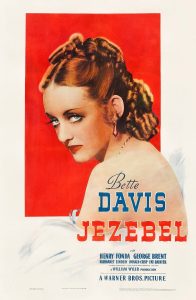
(Wiki Image).
- “There are some things a lady just doesn’t do!” – A character expressing disapproval of Julie’s rebellious behavior.
- “I never intended to hurt you, Preston. But I couldn’t bear to lose you.” – Julie, revealing her true feelings and insecurities.
- “You can’t make someone love you, Julie. All you can do is deserve it.” – A line highlighting the importance of self-reflection and emotional honesty.
- “I’m afraid of myself, Buck. I’m afraid of what I might do.” – Julie, grappling with her destructive tendencies.
- “Maybe love isn’t all sunshine. Maybe it’s a little rough and tumble too.” – A line hinting at the challenges and complexities of love.
Jezebel (1938) Official Trailer – Bette Davis Movie
(YouTube video)
Absolutely, “Jezebel” (1938) is a classic dramatic film starring Bette Davis and Henry Fonda. Here’s a breakdown of the key elements:
Plot:
Set in the American South on the eve of the Civil War, the story revolves around Julie Marsden (Bette Davis), a headstrong and rebellious Southern belle. Engaged to the upright banker Preston Dillard (Henry Fonda), Julie’s impulsive and manipulative behavior creates a scandal.
At a social gathering, she defiantly wears a red dress, defying the tradition of white for unmarried women. This act of defiance is seen as a public insult to Preston and their upcoming marriage. Humiliated and heartbroken, Preston breaks off the engagement and leaves town.
Years pass, and Preston returns home – married to another woman. Consumed by regret and jealousy, Julie seeks revenge. However, a twist in fate and the outbreak of a yellow fever epidemic forces her to confront her true feelings and make a difficult choice.
Characters:
- Julie Marsden (Bette Davis): A spoiled and proud Southern belle who struggles with her pride and learns a harsh lesson about love and loss.
- Preston Dillard (Henry Fonda): A principled and honorable man deeply hurt by Julie’s actions.
- Buck Cantrell (George Brent): A charming gambler entangled with Julie after Preston’s departure.
Themes:
- The Price of Pride: The film explores the destructive consequences of pride and stubbornness, particularly in the context of love and relationships.
- Second Chances: While Julie initially seeks revenge, the film presents the possibility of redemption and forgiveness.
- Social Conformity: The film touches upon the stifling social expectations placed upon women in the pre-Civil War South.
- Love and Regret: The film explores the complexities of love, the pain of lost opportunities, and the power of regret.
Background:
- The film was a critical and commercial success, earning Bette Davis her second Academy Award for Best Actress.
- “Jezebel” has been compared to “Gone With the Wind” (1939), another classic film set in the same time period. However, “Jezebel” offers a darker, more personal exploration of love and loss.
I hope this provides a comprehensive “Jezebel” (1938) overview. Let me know if you have any other questions!
“Dark Victory” (1939)
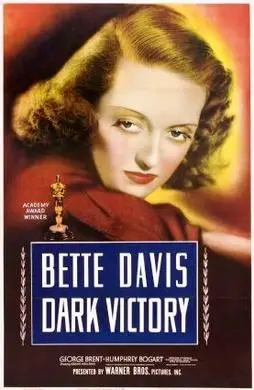
(Wiki Image).
- “Why should I die? I don’t want to die. I want to live!” – Judith, expressing her fear and defiance in the face of her illness.
- “Don’t you think a woman can be successful and still be feminine?” – This line was possibly delivered in another Bette Davis film, but not in “Dark Victory.” In “Dark Victory,” Judith might say something about finding love and living a meaningful life despite her illness.
- “Maybe some people aren’t meant to be happy.” Joyce also used this line in Dangerous (1935) but not necessarily in Dark Victory.
- “I’d rather have had one moment of great happiness than a lifetime of nothing special.” Judith expresses her desire to experience true love despite her condition’s limitations.
- “You’re blind now, but you can still see. You can see with your heart.” This message concerns hope and finding beauty in life, even with limitations.
Sure, here’s a breakdown of “Dark Victory” (1939), the romantic melodrama film starring Bette Davis and Humphrey Bogart:
Plot:
Judith Traherne (Bette Davis) is a wealthy socialite living a carefree life filled with parties and horses. She learns she has a terminal brain tumor and undergoes surgery. Dr. Frederick Steele (George Brent) operates but cannot remove the entire tumor.
While recovering, Judith meets stablehand Michael O’Leary (Humphrey Bogart), a kind and cynical man who cares for her horses. They develop a close bond, and Judith falls in love with Michael. However, Dr. Steele is also attracted to Judith, creating a romantic triangle.
As Judith cherishes her remaining time, she grapples with her illness, the fear of losing her sight, and the complications of her love life.
Characters:
- Judith Traherne (Bette Davis): A strong-willed and determined woman who must confront her mortality and find meaning in her remaining days.
- Dr. Frederick Steele (George Brent): A skilled surgeon who cares for Judith and develops feelings for her.
- Michael O’Leary (Humphrey Bogart): A cynical but compassionate stable hand who deeply bonds with Judith.
Themes:
- Facing Mortality: The film explores the emotional journey of a young woman confronting a terminal illness and the importance of living life to the fullest.
- Love and Loss: The film portrays the complexities of love amidst difficult circumstances and the fear of losing someone you cherish.
- Sacrifice and Selflessness: The characters grapple with making personal sacrifices for the well-being of others.
- Finding Strength in Adversity: The film highlights the human spirit’s resilience and the ability to find joy even in the face of hardship.
Background:
- “Dark Victory” was a critical and commercial success, and it was nominated for three Academy Awards, including Best Picture, Best Actress for Bette Davis, and Best Original Score.
- The film is known for its emotional impact and portrayal of a strong female character facing adversity.
- It is considered a classic of the melodrama genre and a signature film in Bette Davis’s career.
“The Letter” (1940)
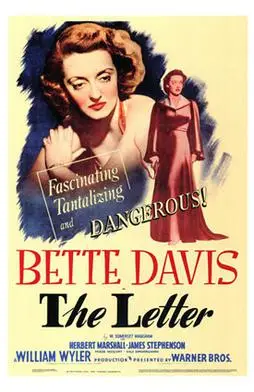
(Wiki Image).
- “I shot him. I killed him. But it was self-defense.” – Leslie, asserting her innocence with a hint of doubt.
- “The tropics bring out the worst in people, don’t they?” – A line hinting at the potential for destructive behavior in a harsh environment.
- “You can’t tell the truth about some things. It wouldn’t be believed.” – Leslie, highlighting the difficulty of maintaining a perfect image when the truth is inconvenient.
- “What a tangled web we weave, when first we practice to deceive!” – A quote from Sir Walter Scott’s poem “Marmion,” spoken in the film to foreshadow the consequences of Leslie’s lies.
- “Love and murder don’t go well together, Mrs. Crosbie.” – Howard, recognizing the situation’s complexity.
“The Letter” (1940) is a film noir classic starring the legendary Bette Davis. Here’s a breakdown of the key elements:
Plot:
Leslie Crosbie (Bette Davis) lives a seemingly idyllic life with her husband, Robert (Herbert Marshall), on a rubber plantation in Malaya. However, their world is shattered when Leslie shoots and kills Geoffrey Hammond (Gale Sondergaard), a visiting businessman.
Leslie claims self-defense, stating that Geoffrey attacked her. Her husband, a devoted and trusting man, readily believes her story. However, the arrival of a new district officer, Howard Joyce (James Stephenson), throws suspicion on Leslie’s account.
As Howard investigates the case, he uncovers a hidden letter Leslie wrote that contradicts her version of events. A web of deceit and manipulation unfolds, revealing a passionate affair and a desperate attempt to cover it up. Now, Howard is caught in the middle, torn between justice and protecting Leslie’s reputation.
Characters:
- Leslie Crosbie (Bette Davis): A beautiful and manipulative woman who will stop at nothing to hide her secrets.
- Robert Crosbie (Herbert Marshall): Leslie’s loving and trusting husband, blind to his wife’s true nature.
- Howard Joyce (James Stephenson): The new district officer, initially sympathetic but determined to uncover the truth.
- Geoffrey Hammond (Gale Sondergaard): The murdered businessman known for his philandering ways.
Themes:
- Deception and Betrayal: The film explores the destructive nature of lies and the lengths people go to maintain a facade.
- Passion and Murder: The story delves into the complexities of human desire and the consequences of acting out of passion.
- Justice vs. Morality: The film raises questions about the pursuit of truth and the potential for collateral damage when uncovering secrets.
- The Power of Appearances: The film portrays the importance of social standing and the lengths people go to maintain a good reputation.
Background:
- “The Letter” was a major box office success and garnered several Academy Award nominations, including Best Picture, Best Actress for Bette Davis, and Best Supporting Actor for Herbert Marshall.
- The film is known for its suspenseful atmosphere, its sharp dialogue, and Bette Davis’ powerful performance as the manipulative femme fatale.
- It is considered a landmark film noir and a must-see for fans of the genre.
“Now, Voyager” (1942)
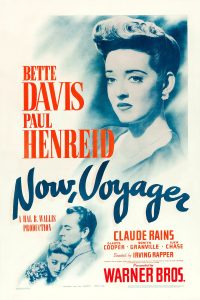
(Wiki Image).
- “Don’t let the past steal your present.” Dr. Jaquith offers Charlotte advice on moving forward.
- “Of all the gin joints in all the world, she walks into mine.” This is a classic line spoken by Rick Blaine (Humphrey Bogart) in “Casablanca” (1942), not “Now, Voyager.” In “Now, Voyager,” Jerry might speak a similar line when meeting Charlotte.
- “You must make your happiness.” is a message of empowerment for Charlotte to take control of her life.
- “Maybe it’s not such a bad thing to be stranded here with you after all.” – Charlotte, acknowledging her growing feelings for Jerry.
- “Now, Voyager. Now, voyager. Chart your course. Never be afraid to sail.” – The film’s iconic and hopeful closing line, encouraging Charlotte to embrace her newfound freedom.
“Now, Voyager” (1942) is a classic romantic drama starring Bette Davis and Paul Henreid. Here’s a breakdown of the key elements:
Plot:
Charlotte Vale (Bette Davis) is a timid and emotionally repressed spinster living under the thumb of her domineering mother (Gladys Cooper). Feeling unappreciated and unloved, Charlotte suffers a mental breakdown.
Her kind-hearted sister-in-law intervenes, and Charlotte is sent to a sanitarium. There, Charlotte transforms under the care of the wise Dr. Jaquith (Claude Rains). She sheds her old inhibitions, embraces a more glamorous appearance, and rediscovers her inner strength.
After leaving the sanitarium, Charlotte embarks on a luxury cruise to South America. Onboard, she encounters a charming and sophisticated married man, Jerry Durrance (Paul Henreid). They share a passionate but ultimately forbidden romance, as Jerry is trapped in an unhappy marriage.
Characters:
- Charlotte Vale (Bette Davis): A spinster who blossoms into a confident and independent woman after self-discovery.
- Dr. Jaquith (Claude Rains): A compassionate psychiatrist who helps Charlotte heal and reclaim her life.
- Jerry Durrance (Paul Henreid): A married architect who falls in love with Charlotte during the cruise.
- Mrs. Vale (Gladys Cooper): Charlotte’s domineering and controlling mother.
Themes:
- Self-discovery and Transformation: The film explores Charlotte’s journey from a repressed individual to a confident and self-assured woman.
- Breaking Free from Domination: The film portrays Charlotte’s struggle to escape her mother’s stifling control and forge her own path.
- Forbidden Love and Sacrifice: Charlotte and Jerry’s love story is passionate but ultimately doomed due to his existing marriage.
- Importance of Independence: The film celebrates Charlotte’s newfound independence and ability to find happiness on her terms.
Background:
- “Now, Voyager” was a major box office success, earning Bette Davis her sixth Academy Award nomination for Best Actress.
- The film is known for its themes of female empowerment, its dramatic and emotional story, and the undeniable chemistry between Davis and Henreid.
- It is considered a classic of Hollywood cinema and a must-see for fans of melodrama and romantic films.
“Mr. Skeffington” (1944)
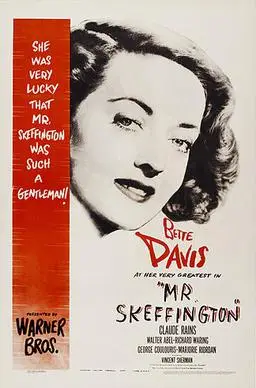
(Wiki Image).
- “Love is a luxury I can’t afford.” This line captures Fanny’s materialistic priorities.
- “I never intended to hurt you, Job. But I couldn’t bear to lose face.” Fanny expresses a hint of remorse for her actions.
- “The world is changing, Fanny. Don’t you see? And not always for the better.” – A line foreshadowing the rise of anti-Semitism.
- “A life wasted is a terrible thing, Job. Don’t let mine be a waste.”—Fanny confronts her regrets in her later years.
- “Perhaps growing old isn’t so bad after all. Perhaps it gives you a chance to see things more clearly.” This line reflects on the wisdom gained through experience.
Here’s a breakdown of “Mr. Skeffington” (1944), the dramatic film starring Bette Davis and Claude Rains:
Plot:
The film follows the story of Fanny Trellis (Bette Davis), a beautiful and self-centered socialite living in pre-WWI England. Surrounded by suitors, Fanny sets her sights on Job Skeffington (Claude Rains), a wealthy Jewish banker.
However, her motives are far from love. Fanny’s brother, Trippy (Richard Waring), is facing embezzlement charges, and marrying Skeffington is a calculated move to secure her family’s reputation. Skeffington, initially hesitant due to their age difference, eventually agrees, smitten by Fanny’s beauty.
As the years pass, the couple’s relationship becomes strained. Fanny remains aloof and unfulfilled, while Skeffington grapples with the rise of anti-Semitism in Europe. The outbreak of World War I further disrupts their lives, taking a toll on their family and sense of security.
Characters:
- Fanny Trellis (Bette Davis): A narcissistic socialite who enters a loveless marriage for convenience, ultimately facing the consequences of her shallowness.
- Job Skeffington (Claude Rains): A wealthy Jewish banker who falls for Fanny’s beauty but struggles with her coldness and the rise of anti-Semitism.
- Trippy Trellis (Richard Waring): Fanny’s charming but irresponsible brother whose actions set the story in motion.
Themes:
- Superficiality vs. True Love: The film contrasts Fanny’s materialistic desires with the possibility of genuine love that she overlooks.
- Consequences of Choices: The film explores how Fanny’s manipulative actions have repercussions for herself and those around her.
- Anti-Semitism: The film portrays the rise of anti-Semitism in Europe leading up to World War II, adding a layer of social commentary.
- Regret and Loss: As Fanny ages and reflects on her life, she grapples with feelings of regret and the loss of potential happiness.
Behind the Scenes:
- “Mr. Skeffington” was a critical and commercial failure upon its release. Some critics found the portrayal of Fanny to be unlikeable, and the film’s dark ending contrasted with the more optimistic wartime films of the era.
- However, the film has been reevaluated in recent years, with some appreciating its complex characters and its exploration of social issues.
- The film is also notable for featuring Claude Rains in a rare sympathetic role.
Later Career and Legacy
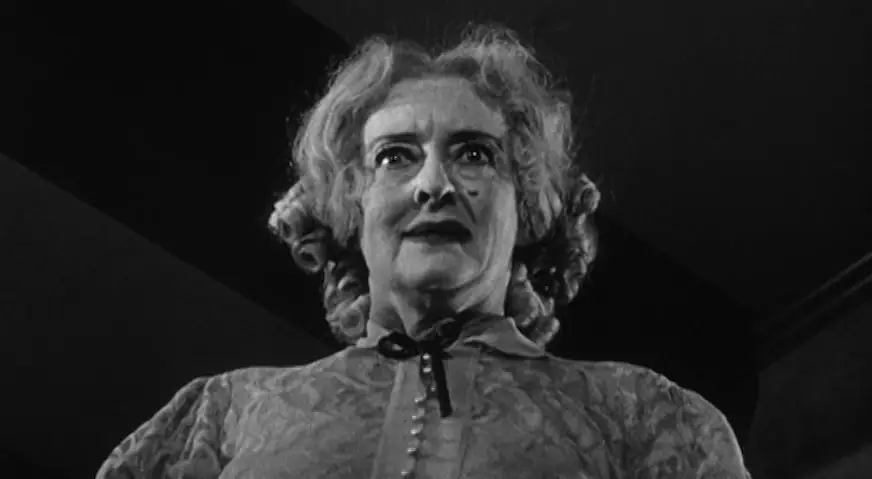
Davis received her final Academy Award nomination for her role as demented “Baby Jane” Hudson in What Ever Happened to Baby Jane? (1962) (Wiki Image).
Bette Davis’ career spanned over six decades, and while her reign as a top box office star waned in the 1940s, she remained a formidable force in Hollywood. Here’s a breakdown of her later career and enduring legacy:
Later Career:
- Shifting Focus: After facing challenges finding leading roles in the 1950s, Davis successfully transitioned to character parts, showcasing her versatility.
- Stage and Television: She succeeded on stage and in television, winning an Emmy Award for her performance in “Strangers: The Story of a Mother and Daughter” (1979).
- Memorable Roles: She continued to deliver powerful performances in films like “Whatever Happened to Baby Jane?” (1962), “Hush…Hush, Sweet Charlotte” (1964), and “Death on the Nile” (1978).
Legacy:
- Iconic Status: Bette Davis is considered one of the greatest actresses of the Golden Age of Hollywood. She was known for her fierce intelligence, strong work ethic, and willingness to take on challenging and unconventional roles.
- Breaking Barriers: She challenged Hollywood stereotypes and paved the way for more complex female characters on screen.
- Academy Recognition: Davis holds the record for most Academy Award nominations for Best Actress (10) and won the award twice, for “Jezebel” (1938) and “Dangerous” (1935).
- Influence: Her talent, tenacity, and outspoken personality inspired generations of actresses.
Here are some additional points to consider:
- Feuds: Davis was known for her fiery personality and had well-publicized feuds with other actresses, notably Joan Crawford.
- Health Struggles: She battled breast cancer and continued to work despite her declining health.
- Autobiography: Her autobiography, “A Story of Survival,” offers insights into her life and career.
Bette Davis’ legacy goes beyond her awards and accolades. She is remembered for her captivating screen presence, dedication to her craft, and unwavering spirit. She left an indelible mark on Hollywood and continues to inspire actors and filmmakers today.
“What Ever Happened to Baby Jane?” (1962)
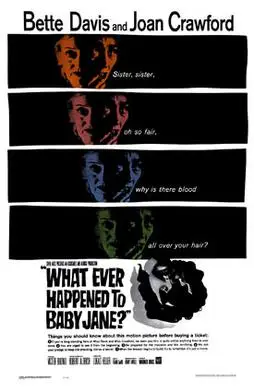
(Wiki Image).
- “Whatever happened to Baby Jane? To her smile, her golden hair? Why must everything be so unfair? Is there no one left to care?” – This haunting song, sung throughout the film, reflects Jane’s faded stardom and the mystery surrounding her decline.
- “Blanche Hudson! You’ve been a hard woman to handle all your life! But you’re going to be easy to get rid of!” – Jane, in a chilling moment, reveals her manipulative and potentially dangerous intentions towards Blanche.
- “You see these lines around my eyes? They’re laugh lines! From all the laughs I gave the world!” – Jane, clinging to a distorted memory of her past glory, desperately tries to convince herself and others of her enduring charm.
- “You can lead a horse to water, but you can’t make him drink… unless he’s thirsty!” – Edwin Flagg, with his limited intelligence, delivers this line in a darkly comedic moment, highlighting the power dynamics at play.
- “No wire hangers, ever!” – This now-iconic line, delivered with manic intensity by Jane, has become a pop culture reference, encapsulating her controlling and obsessive personality.
“What Ever Happened to Baby Jane?” (1962) is a psychological horror thriller that marked a significant point in Bette Davis’ career. Here’s a breakdown of the key elements:
Plot:
The film centers around two aging sisters, Jane Hudson (Bette Davis) and Blanche Hudson (Joan Crawford), who live a decaying Hollywood mansion.
- Former Glories: Jane was once a celebrated child star, while Blanche was a successful actress in her adult years.
- Shifting Fortunes: A car accident years ago left Blanche paralyzed while Jane’s career faded into obscurity.
- Twisted Relationship: Jane, now delusional and abusive, torments the wheelchair-bound Blanche, fueled by jealousy and resentment.
- Desperation and Deception: Jane desperately clings to the remnants of her fame and concocts a twisted scheme to revive her career, further isolating Blanche.
- Suspense and Mystery: The film builds suspense by keeping the details of the car accident murky, hinting at a darker secret.
Characters:
- Jane Hudson (Bette Davis): A former child star now mentally unstable and abusive towards her sister.
- Blanche Hudson (Joan Crawford): A once-famous actress is now a paraplegic victim of her sister’s cruelty.
- Edwin Flagg (Victor Buono): A hunky but dim-witted pianist hired by Jane to accompany her comeback performance.
Themes:
- Faded Stardom and Aging: The film explores the anxieties of fading fame and the challenges of aging in Hollywood.
- Sibling Rivalry and Jealousy: The twisted relationship between the sisters is a central theme, showcasing the destructive power of envy.
- Mental Deterioration and Abuse: Jane’s descent into madness and her subsequent abuse of Blanche is a disturbing portrayal of psychological decline.
- Illusion vs. Reality: The film blurs the lines between Jane’s delusional perception and Blanche’s repressed memories.
Impact and Legacy:
- Cult Classic Status: “What Ever Happened to Baby Jane?” achieved cult classic status, praised for its campy elements, dark humor, and the legendary performances of Davis and Crawford.
- Rejuvenated Careers: The film revitalized the careers of both Davis and Crawford, showcasing their ability to take on challenging and unconventional roles.
- Exploration of Darker Sides: It paved the way for more films exploring the psychological complexities of aging and the darker sides of human nature.
- Enduring Cultural Reference: The film’s title and iconic lines like “Whatever happened to Baby Jane?” continue to be referenced in pop culture.
Interesting Facts:
- The real-life rivalry between Bette Davis and Joan Crawford is well-documented, and some believe it fueled the on-screen tension.
- The film was shot in black and white, adding to the gothic atmosphere.
- “What Ever Happened to Baby Jane?” is considered an early example of the “psycho-biddy” genre, featuring deranged older women.
Despite its dark themes and unsettling atmosphere, “What Ever Happened to Baby Jane?” remains a captivating film. It’s a testament to the power of great performances, the exploration of complex characters, and the enduring appeal of Hollywood’s dark side.
Similarities and Differences Between Meryl Streep, Katharine Hepburn, and Bette Davis Compared.
Similarities:
- Legendary Actresses: All three are considered icons of American cinema, leaving a lasting impact on Hollywood.
- Chameleon-like Acting: All are known for their incredible range and ability to disappear into diverse roles.
- Award Recognition: Each received numerous Academy Award nominations for Best Actress, showcasing their talent in the film industry.
- Strong Female Characters: They often portrayed strong, independent women who challenged societal norms.
- Talent and Versatility: All three actresses are widely recognized for their exceptional talent and versatility in portraying a wide range of characters across various genres.
- Longevity: Streep, Hepburn, and Davis enjoyed long and illustrious careers in Hollywood, spanning several decades.
- Influence: They have all profoundly influenced future generations of actors and actresses, shaping the craft of acting and setting standards for performance excellence.
Differences:
- Era:
- Hepburn: Golden Age of Hollywood (1930s-1950s)
- Davis: Golden Age of Hollywood (peaked in the 1940s)
- Streep: Modern Hollywood (from the 1970s to present)
- Acting Style:
- Hepburn: Known for her elegance, wit, and sharp delivery. Some might say occasionally “hammy.”
- Davis: Fierce and intense, often playing complex, morally ambiguous characters.
- Streep: Renowned for her meticulous character study and ability to flawlessly embody accents and mannerisms.
- Screen Presence:
- Hepburn: Often projected an air of sophistication and strength on screen.
- Davis: Possessed a magnetic on-screen presence, known for her sharp gaze and powerful delivery.
- Streep: Disappears into her roles, allowing the character to take center stage.
Overall, these three actresses share a deep love for their craft and a dedication to portraying complex female characters. However, their distinct eras, acting styles, and screen personas set them apart as unique and captivating performers.
Meryl Streep, Katharine Hepburn, and Bette Davis are alive today at the height!
Imagining Meryl Streep, Katharine Hepburn, and Bette Davis alive and at the height of their careers today is an intriguing thought experiment! Here’s how the landscape of Hollywood and the possibilities they might face would differ from their eras:
Challenges
- Ageism in Hollywood: While there have been some positive shifts, ageism remains a significant hurdle for women in Hollywood. These actresses face challenges finding consistent leading roles, especially compared to their prime years.
- Shifting Audience Preferences: Blockbuster franchises and superhero movies dominate the box office now. The types of complex, character-driven dramas these actresses excelled in are less common than theatrical releases.
- Social Media and the Celebrity Machine: Modern fame demands constant engagement with social media and the press. Hepburn, known for her privacy, might dislike this, while Davis might find ways to use it to her advantage.
Opportunities
- Prestige Television and Streaming: Platforms like HBO, Netflix, and others produce high-quality dramas with complex female characters. This could be a fantastic space for these actresses to explore multi-season character arcs and nuanced roles.
- Advocacy and Mentorship: As powerful figures, they have the potential to use their voices for change in the industry, fighting for better representation for women and diverse voices and championing projects they believe in.
- Independent Cinema: The independent film scene continues to produce challenging and exciting work, especially for seasoned actors willing to take creative risks.
Potential Paths
- Meryl Streep: Given her versatility, Streep would likely thrive across mediums. We could see her in acclaimed prestige dramas on TV and taking on supporting roles in quirky indie films or even the occasional blockbuster.
- Katharine Hepburn: Hepburn might focus primarily on independent films and select stage productions, roles tailored to her unique personality. She could also become a vocal and intriguing figure, offering insightful and sometimes controversial industry commentary.
- Bette Davis: Davis’s bold personality and penchant for strong characters could lead her to fascinating anti-hero roles. With her at the helm, a limited series exploring a layered, morally complex older woman would be incredible.
Overall Impact
Their continued presence in today’s Hollywood would be a force to be reckoned with. They could:
- Challenge Expectations: Their success would counter ageism and prove the audience’s appetite for stories with seasoned, complex female leads.
- Inspire New Generations: They could mentor and pave the way for the next generation of actresses and filmmakers.
- Influence Content: Their star power could open opportunities for new types of stories and roles that Hollywood usually ignores.
While imagining their modern careers is certainly fun, the most important reminder is that these three women have already made incredible, lasting contributions to cinema. Their legacies are secure, even if we can only speculate about their potential in today’s entertainment world.
Let me know if you’d like to focus on a specific actress or a potential role you can imagine them taking on today!

